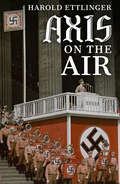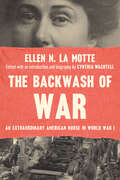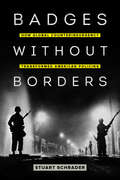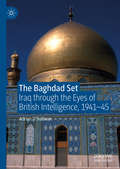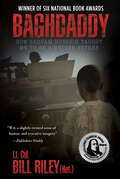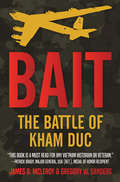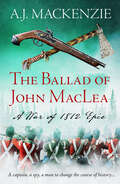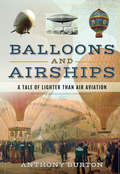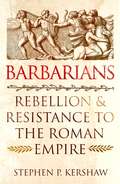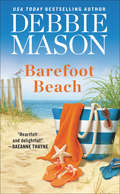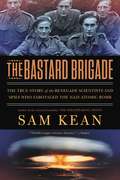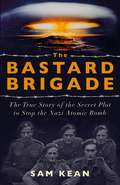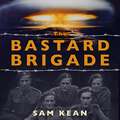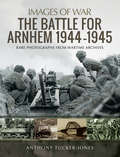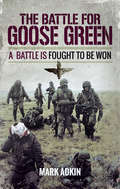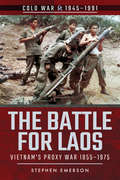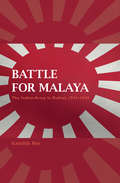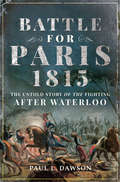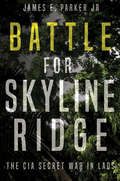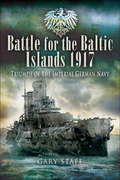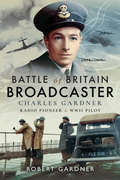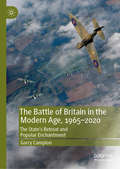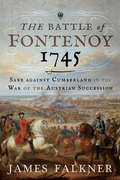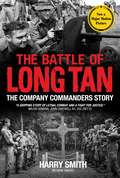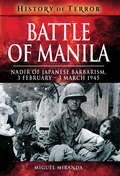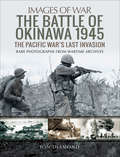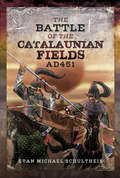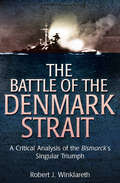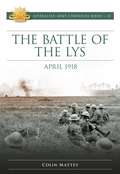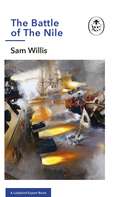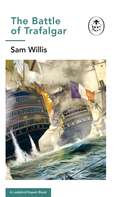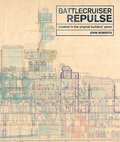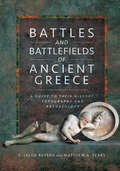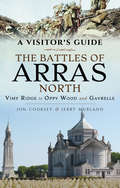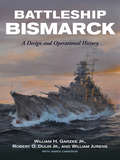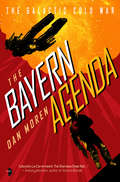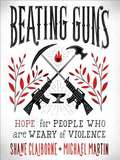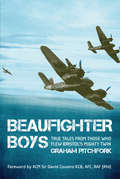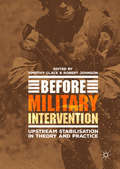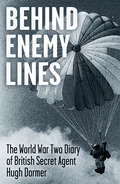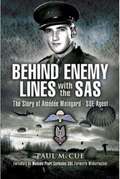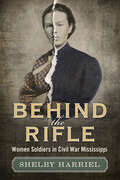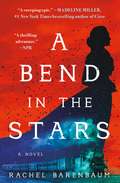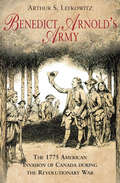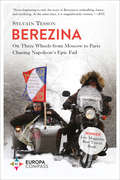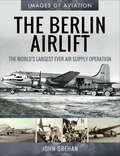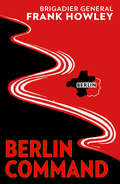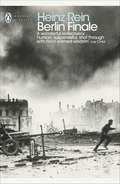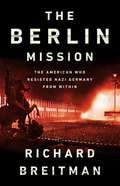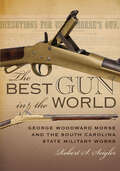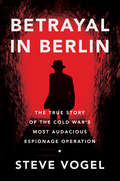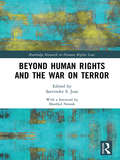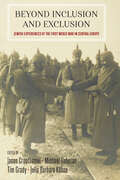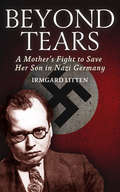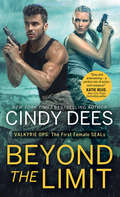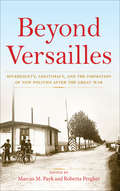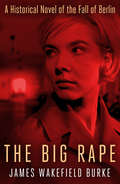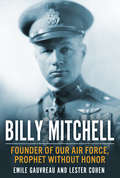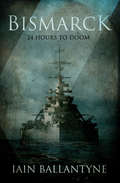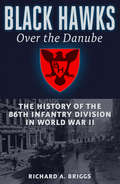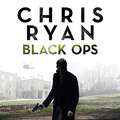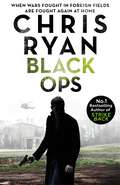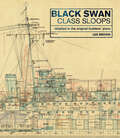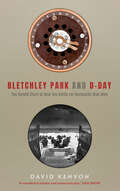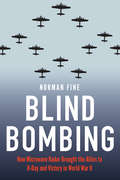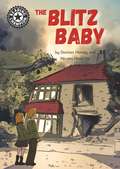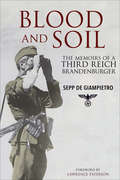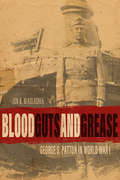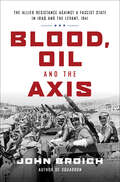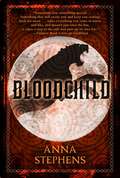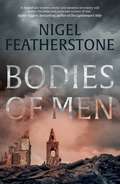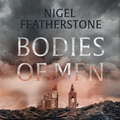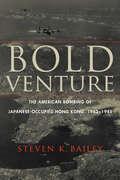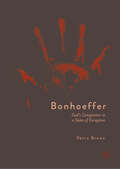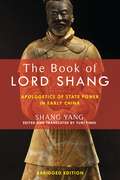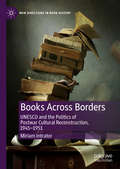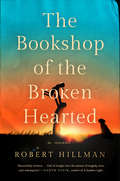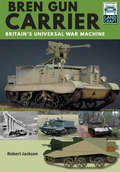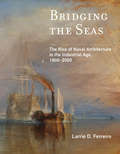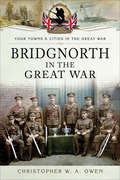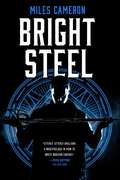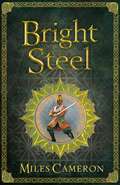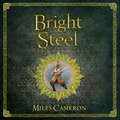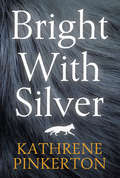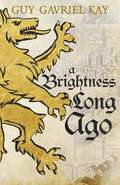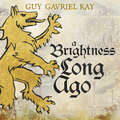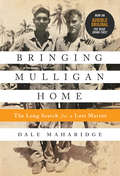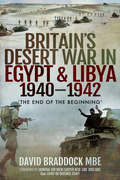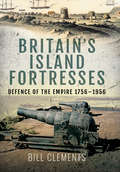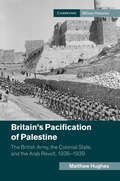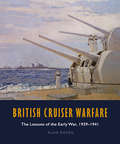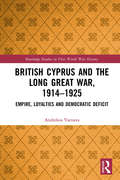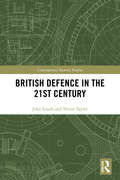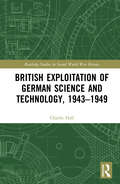- Table View
- List View
Axis on the Air
by Harold L. EttlingerThe Axis on the Air, first published in 1943, is a fascinating look at the use of radio for propaganda purposes by the Nazis, Japanese, and Italians during World War II. Author Harold Ettlinger, a columnist for the Chicago Sun, provides insight and numerous examples of Nazi Propaganda Minister Goebbels, famous traitors such as “Lord Haw Haw,” Jane Anderson, and Ezra Pound, and Axis broadcasts to its own citizens as well as efforts to create unrest and lower morale in England and the United States. The book also examines Allied radio services such as the BBC and Voice of America, plus radio stations in some of the smaller European countries such as Sweden and Finland.A vivid, authentic description of how the Axis, led by Goebbels, has used the radio as a weapon for subjugating its enemies.
The Backwash of War: An Extraordinary American Nurse in World War I
by Ellen N. La MotteBanned in multiple countries for its frank depiction of the horrors of war, Ellen N. La Motte's The Backwash of War is one of the most stunning antiwar books ever published."We are witnessing a phase in the evolution of humanity, a phase called War—and the slow, onward progress stirs up the slime in the shallows, and this is the Backwash of War. It is very ugly."—Ellen N. La MotteIn September 1916, as World War I advanced into a third deadly year, an American woman named Ellen N. La Motte published a collection of stories about her experience as a war nurse. Deemed damaging to morale, The Backwash of War was immediately banned in both England and France and later censored in wartime America. At once deeply unsettling and darkly humorous, this compelling book presents a unique view of the destruction wrought by war to the human body and spirit. Long neglected, it is an astounding book by an extraordinary woman and merits a place among major works of WWI literature. This volume gathers, for the first time, La Motte's published writing about the First World War. In addition to Backwash, it includes three long-forgotten essays. Annotated for a modern audience, the book features both a comprehensive introduction to La Motte's war-time writing in its historical and literary contexts and the first extended biography of the "lost" author of this "lost classic." Not only did La Motte boldly breach decorum in writing The Backwash of War, but she also forcefully challenged societal norms in other equally remarkable ways, as a debutante turned Johns Hopkins–trained nurse, pathbreaking public health advocate and administrator, suffragette, journalist, writer, lesbian, and self-proclaimed anarchist.
Badges without Borders: How Global Counterinsurgency Transformed American Policing (American Crossroads #56)
by Stuart SchraderFrom the Cold War through today, the U.S. has quietly assisted dozens of regimes around the world in suppressing civil unrest and securing the conditions for the smooth operation of capitalism. Casting a new light on American empire, Badges Without Borders shows, for the first time, that the very same people charged with global counterinsurgency also militarized American policing at home. In this groundbreaking exposé, Stuart Schrader shows how the United States projected imperial power overseas through police training and technical assistance—and how this effort reverberated to shape the policing of city streets at home. Examining diverse records, from recently declassified national security and intelligence materials to police textbooks and professional magazines, Schrader reveals how U.S. police leaders envisioned the beat to be as wide as the globe and worked to put everyday policing at the core of the Cold War project of counterinsurgency. A “smoking gun” book, Badges without Borders offers a new account of the War on Crime, “law and order” politics, and global counterinsurgency, revealing the connections between foreign and domestic racial control.
The Baghdad Set: Iraq through the Eyes of British Intelligence, 1941–45
by Adrian O'SullivanThis book provides the first ever intelligence history of Iraq from 1941 to 1945, and is the third and final volume of a trilogy on regional intelligence and counterintelligence operations that includes Nazi Secret Warfare in Occupied Persia (Iran) (2014), and Espionage and Counterintelligence in Occupied Persia (Iran) (2015). This account of covert operations in Iraq during the Second World War is based on archival documents, diaries, and memoirs, interspersed with descriptions of all kinds of clandestine activity, and contextualized with analysis showing the significance of what happened regionally in terms of the greater war. After outlining the circumstances of the rise and fall of the fascist Gaylani regime, Adrian O’Sullivan examines the activities of the Allied secret services (CICI, SOE, SIS, and OSS) in Iraq, and the Axis initiatives planned or mounted against them. O'Sullivan emphasizes the social nature of human intelligence work and introduces the reader to a number of interesting, talented personalities who performed secret roles in Iraq, including the distinguished author Dame Freya Stark.
Baghdaddy: How Saddam Hussein Taught Me to Be a Better Father
by Lt. Col. Bill RileyAmerican Book Fest’s Best Book Awards Winner for Best Nonfiction Book of 2019 Military Writers Society of America Multiple Award-Winner: Founder’s Award for Standout Book of 2019 Gold Medal Award for Memoir category For readers of Educated and The Glass Castle, a moving new memoir about survival, family, and a humanizing insight into the individuals who fight the nation’s wars. As a child, he was raised in an unstable and violent home by a mother struggling with mental illness. An absent father with a firm belief in tough love left him with only his sister to understand or comfort him as they faced a home full of harshness, resentment, and physical abuse. As a man, he braved the war-torn landscapes of Kuwait, Iraq, and Saudi Arabia. Having learned early from his father that only the strong survive, he enlisted in the Air Force after high school and began an impressive military career in intelligence analysis, communications, and supporting special operations, meeting incredible individuals along the way. In his time overseas he faced harsh realities of the politics of war, the consequences of military actions, and the challenge of attempting to rebuild a country while its own people are trying to kill you. Baghdaddy is Bill Riley’s memoir: an honest and colorful depiction of his journey through a turbulent youth and into a challenging adulthood. This very human account of living in some of the least humane environments delivers the message that no matter how different we seem, we are all trying to make the best of life and learn how to be the best versions of ourselves.
Bait: The Battle of Kham Duc
by James D. McLeroy Gregory W. SandersA history of one of the least known and most misunderstood battles in the Vietnam War.The strategic potential of the three-day attack of two North Vietnamese Army (NVA) regiments on Kham Duc, a remote and isolated Army Special Forces camp, on the eve of the first Paris peace talks in May 1968, was so significant that former President Lyndon Johnson included it in his memoirs. This gripping, original, eyewitness narrative and thoroughly researched analysis of a widely misinterpreted battle at the height of the Vietnam War radically contradicts all the other published accounts of it. In addition to the tactical details of the combat narrative, the authors consider the grand strategies and political contexts of the U.S. and North Vietnamese leaders.Praise for Bait: The Battle of Kham Duc“This book is a must read for any Vietnam historian or veteran.” —Patrick Brady, Major General, USA (ret.), Medal of Honor Recipient“For an authentic, detailed view of how large battles between U.S. combined-arms forces and regular North Vietnamese Army forces were fought in Vietnam in 1968, Bait: The Battle of Kham Duc is required reading.” —General H. Hugh Shelton, 14th Chairman, Joint Chiefs of Staff“This first-hand, exhaustively documented account of a large battle in the Vietnam War shows the decisive role of air power in all its forms.” —Carl Schneider, Major General, USAF (ret.)“One of those rare historical narratives that explains in rich detail a battle that was little understood or reported on at the time it was fought but was of strategic importance and heroic dimension.” —Marine Corps Gazette“The account of the battle is both detailed and exceptionally well-written; McLeroy’s participation in the battle adds authenticity to the narrative.... Highly recommended for anyone interested in how large-scale battles were fought in Vietnam at the height of U.S. commitment on the ground there.” —Journal of Military History
The Ballad of John MacLea (The War of 1812 Epics)
by A.J. MacKenzieA ring of spies, a battle of lies, and one man who can change the tide of war. The first War of 1812 Epic from the author of The Hunt for the North Star. Stationed with British militia in Upper Canada in late 1812, Captain John MacLea is charting his own course against a background of uncertain loyalties and certain danger. Tasked with routing out enemy agents and thwarting an elaborate espionage ring, MacLea soon discovers that there is a traitor in their ranks, organizing a devastating plot. Events spiral out of control, culminating in a dramatic showdown aboard a captured American warship headed for the breach at Niagara Falls. Failure may mean the loss of the war . . . failure is not an option. Gripping, compelling, and anchored in detailed historical research, The Ballad of John MacLea is a triumph, perfect for fans of Adrian Goldsworthy, Iain Gale and Bernard Cornwell. Praise for the novels of A. J. MacKenzie &“Unputdownable . . . I was blown away.&” —Angus Donald, international bestselling author of the Outlaw Chronicles &“Truly enthralling.&” —Paul Doherty, author of Dark Queen Wary &“A rip-roaring story and devilish plot with outstanding historical detail.&” —C. B. Hanley, author of the Mediaeval Mysteries series
Balloons and Airships: A Tale of Lighter Than Air Aviation
by Anthony Burton&“Looks at the brave (and sometimes foolish) men and women who were responsible for . . . the development of manned flight&” (History of War). This book tells the often dramatic and always fascinating story of flight in lighter than air machines. For centuries man had dreamed of flying, but all attempts failed, until in 1782 the Montgolfier brothers constructed the world&’s first hot air balloon. The following year saw the first ascent with aeronauts—not human beings but a sheep, a duck and a cockerel. But it was not long before men and women too took to the air and became ever more adventurous. In the 19th century, balloons found a new role in the military. But their use was always limited by the fact that they were at the mercy of the wind. There were numerous attempts at steering balloons, and various attempts were made to power them but it was the arrival of the internal combustion engine that saw the balloon transformed into the airship. The most famous developer of airships was Graf von Zeppelin, and the book tells the story of the use of his airships in both peacetime and at war. There were epic adventures including flights over the poles and for a time, commercial airships flourished—then came the disaster of the Hindenburg. Airships still fly today and ballooning has become a hugely popular pastime. &“Entertaining and informative . . . a series of interesting snapshots, giving a flavor of these challenging and daring exploits.&” —Flying in Ireland &“Absolutely enthralling.&” —Books Monthly
Barbarians: Rebellion and Resistance to the Roman Empire
by Dr Stephen P. KershawA fresh new look at the Roman Empire, from the point of view of those regarded by the Romans as 'barbarians'. Kershaw builds a narrative around the lives, personalities, successes and failures both of the key opponents of Rome's rise and dominance, and of the those who ultimately brought the empire down.'And now what will become of us without barbarians?Those people were a sort of solution.' 'Waiting for the Barbarians' C. P. CavafyHistory is written by the victors, and Rome had some very eloquent historians. Those the Romans regarded as barbarians left few records of their own, but they had a tremendous impact on the Roman imagination. Resisting from outside Rome's borders or rebelling from within, they emerge vividly in Rome's historical tradition, and left a significant footprint in archaeology.Rome's history, as written by the Romans, follows a remarkable trajectory from its origins as a tiny village of refugees from a conflict zone to a dominant superpower, before being transformed into the medieval and Byzantine worlds. But throughout this history, Rome faced significant resistance and rebellion from peoples whom it regarded as barbarians. Gibbon saw the Roman Empire as one of the highest points of human achievement destroyed by barbarian invaders: Ostrogoths, Visigoths, Goths, Vandals, Huns, Picts and Scots. To others, as Rome was ravaged, new life was infused into an expiring Italy. Gibbon's 'decline and fall' has been reappraised as transformation, through religious and cultural revolution. Based both on ancient historical writings and modern archaeological research, this new history takes a fresh look at the Roman Empire, through the personalities and lives of key opponents of Rome's rise, dominance and fall - or transformation. These include: Brennus, the Gaul who sacked Rome; the Plebs, those barbarous insiders and internal resistors; Hannibal; Viriathus, the Iberian shepherd and skilled guerilla; Jugurtha and the struggle to free Africa; the Germanic threat from the Cimbri and the Teutones; Spartacus, the gladiator; Vercingetorix and rebellion in Gaul; Cleopatra; Boudicca, the Queen of the Iceni and the scourge of Rome; the Great Jewish Revolt; Alaric the Goth and the Sack of Rome; Attila the Hun, 'Born to Shake the Nations'; and the Vandals and the fall of Rome.
Barefoot Beach (Harmony Harbor #8)
by Debbie MasonCan a summer of love make up for a lifetime of secrets?Wedding fever has taken over Harmony Harbor this summer, and the local matchmakers have set their sights on Theia Lawson, a former navy pilot who's in town for a stay at Greystone Manor. And while Theia's got her reasons to put this small town behind her as fast as she can, there's a certain tall, dark, and irresistible man that she can't seem to get off her mind. Firefighter Marco DiRossi wants to beat the matchmakers at their own game so he conspires with Theia to pretend they've already fallen in love. It's only for the summer. What could go wrong? Yet as the beach season draws to a close, Marco and Theia find their pretend relationship has led to very real attraction. But when a secret from the past is revealed, jeopardizing everything they hold dear, can this unlikely couple find their way to a happily-ever-after?
The Bastard Brigade: The True Story of the Renegade Scientists and Spies Who Sabotaged the Nazi Atomic Bomb
by Sam KeanFrom New York Times bestselling author Sam Kean comes the gripping, untold story of a renegade group of scientists and spies determined to keep Adolf Hitler from obtaining the ultimate prize: a nuclear bombScientists have always kept secrets. But rarely have the secrets been as vital as they were during World War II. In the middle of building an atomic bomb, the leaders of the Manhattan Project were alarmed to learn that Nazi Germany was far outpacing the Allies in nuclear weapons research. Hitler, with just a few pounds of uranium, would have the capability to reverse the entire D-Day operation and conquer Europe. So they assembled a rough and motley crew of geniuses - dubbed the Alsos Mission - and sent them careening into Axis territory to spy on, sabotage, and even assassinate members of Nazi Germany's feared Uranium Club. The details of the mission rival the finest spy thriller, but what makes this story sing is the incredible cast of characters-both heroes and rogues alike-including: Moe Berg the major league catcher who abandoned the game for a career as a multilingual international spy; the strangest fellow to ever play professional baseball.Werner Heisenberg the Nobel Prize-winning physicist credited as the discoverer of quantum mechanics; a key contributor to the Nazi's atomic bomb project and the primary target of the Alsos mission. Colonel Boris Pash a high school science teacher and veteran of the Russian Revolution who fled the Sovit Union with a deep disdain for Communists and who later led the Alsos mission. Joe Kennedy Jr. the charismatic, thrill-seeking older brother of JFK whose need for adventure led him to volunteer for the most dangerous missions the Navy had to offer. Samuel Goudsmit a washed-up physics prodigy who spent his life huntinh Nazi scientist-and his parents, who had been swept into a concentration camp-across the globe. Irène and Frederic Joliot-Curie a physics Nobel-Prize winning power couple who used their unassuming status as scientists to become active members of the resistance. Thrust into the dark world of international espionage, these scientists and soldiers played a vital and largely untold role in turning back one of the darkest tides in human history.
The Bastard Brigade: The True Story of the Renegade Scientists and Spies Who Sabotaged the Nazi Atomic Bomb
by Sam KeanScientists have always kept secrets. But rarely in history have scientific secrets been as vital as they were during World War II. In the midst of planning the Manhattan Project, the U.S. Office of Strategic Services created a secret offshoot - the Alsos Mission - meant to gather intelligence on and sabotage if necessary, scientific research by the Axis powers. What resulted was a plot worthy of the finest thriller, full of spies, sabotage, and murder. At its heart was the 'Lightning A' team, a group of intrepid soldiers, scientists, and spies - and even a famed baseball player - who were given almost free rein to get themselves embedded within the German scientific community to stop the most terrifying threat of the war: Hitler acquiring an atomic bomb of his very own.While the Manhattan Project and other feats of scientific genius continue to inspire us today, few people know about the international intrigue and double-dealing that accompanied those breakthroughs. Bastard Brigade recounts this forgotten history, fusing a non-fiction spy thriller with some of the most incredible scientific ventures of all time.
The Bastard Brigade: The True Story of the Renegade Scientists and Spies Who Sabotaged the Nazi Atomic Bomb
by Sam KeanNew York Times bestselling author Sam Kean tells the incredible story of how a renegade group of spies kept Hitler from obtaining his ultimate prize: a nuclear bomb.Scientists have always kept secrets. But rarely in history have scientific secrets been as vital as they were during World War II. In the midst of planning the Manhattan Project, the U.S. Office of Strategic Services created a secret offshoot - the Alsos Mission - meant to gather intelligence on and sabotage if necessary, scientific research by the Axis powers. What resulted was a plot worthy of the finest thriller, full of spies, sabotage, and murder. At its heart was the 'Lightning A' team, a group of intrepid soldiers, scientists, and spies - and even a famed baseball player - who were given almost free rein to get themselves embedded within the German scientific community to stop the most terrifying threat of the war: Hitler acquiring an atomic bomb of his very own.While the Manhattan Project and other feats of scientific genius continue to inspire us today, few people know about the international intrigue and double-dealing that accompanied those breakthroughs. Bastard Brigaderecounts this forgotten history, fusing a non-fiction spy thriller with some of the most incredible scientific ventures of all time.(P) 2019 Hachette Book Group Audio Ltd
The Battle for Arnhem 1944–1945: Rare Photographs From Wartime Archives (Images of War)
by Anthony Tucker-JonesA photographic history of WWII&’s Operation Market Garden and the Allies&’ quest for the famed &“Bridge Too Far.&” Operation Market Garden, September 1944, the Netherlands. Three parachute drops and one armored charge. The prize was the last bridge at Arnhem over the Neder Rijn. Taken intact, it would provide the Allies with a backdoor into Germany—the famous &“Bridge Too Far.&” This was one of the most audacious and imaginative operations of the war, and it failed. Anthony Tucker-Jones&’s photographic history, with a sequence of almost 200 archive photographs accompanied by a detailed narrative, describes the landing of British and American parachutists and glider troops. At the same time, British tanks spearheaded a sixty-mile dash along &“Hell&’s Highway&” to link up with the lightly armed and heavily outnumbered airborne forces. Most books about the resulting battle concentrate on the struggle at Arnhem and the heroism of the British 1st Airborne Division. This book puts that episode in its wider context. In particular it focuses on the efforts of the US 101st and 82nd airborne divisions to hold off counterattacks by German battlegroups during the tanks&’ advance. The photographs give a dramatic insight into all sides of a remarkable but ill-fated operation which has fascinated historians and been the subject of controversy ever since. They also portray, as only photographs can, the men who were involved and the places and conditions in which the fighting took place.
The Battle for Goose Green: A Battle is Fought to be Won (Cassell Military Paperbacks Series)
by Mark Adkin&“Probably the best and most detailed description of a key battle in the 1982 Falklands War . . . an excellent and fast paced narrative.&” —Michael McCarthy, historical battlefield guide This book tells the story of the battle for Goose Green—the first crucial clash of the Falklands War—through the eyes of the commanders, both British and Argentine, from brigadier to corporal. It follows in detail, with the aid of maps, the fourteen hours of vicious infantry as both sides struggled for the tiny settlement of Goose Green. The book explains how 2 Para came close to failure as the battalion fought over open ground, in daylight, without adequate fire support against prepared positions. Controversial questions—such as: Was it an unnecessary battle? Why did London overrule the brigadier commander&’s reluctance to attack? Did Col. Jones&’s solo charge, which won him the Victoria Cross, decide the issue?—are discussed frankly. The author, himself a former infantry officer, has had the full support of the Parachute Regiment, and has assembled the views and comments of over forty-five veterans of all ranks who fought there. &“The Falklands War showed British military personnel at their best and most innovative under the most testing of conditions, and the Battle of Goose Green was one of the classic actions . . . The author has made an impressive job of reviewing the important factors, the events and decisions that led to the battle.&” —Firetrench &“This brought home to me how the infantry fight and how the British Paratrooper has gained a worldwide reputation for being one of the best fighting men around. A superb read.&” —Army Rumour Service
The Battle for Laos: Vietnam's Proxy War, 1955–1975 (Cold War, 1945–1991)
by Stephen EmersonA history of the &“secret war&” in Southeast Asia in which nearly three million tons of bombs decimated a newly independent nation. By 1959 the newly independent Kingdom of Laos was transforming into a Cold War battleground for global superpower competition, having been born out of the chaos following the French military defeat and withdrawal from Indochina in 1954. The country was soon engulfed in a rapidly evolving civil war as rival forces jockeyed for power and swelling foreign intervention intensified the fighting. Adding even more fuel to the fire, &“neutral&” Laos&’s geographic entanglement in the war in neighboring South Vietnam deepened in the early 1960s as Hanoi&’s reliance on the Ho Chi Minh Trail for moving men and matériel through the southern Laotian panhandle grew exponentially, making it a priority target of American interdiction efforts. For almost twenty years, the fighting between the Western-supported Royal Lao government and the communist-supported Pathet Lao would rage across the plains, jungles, and mountaintops largely unseen by most of the world. Thousands on each side would die and many more would be displaced as the conflict on the ground ebbed and flowed from season to season and year to year. And in the skies above, American and Royal Laotian aircraft would rain down their deadly payloads, decimating large swaths of the countryside in pursuit of victory. Nearly three million tons of bombs would be dropped on Laotian territory between 1965 and 1973, leaving a legacy of unexploded ordnance that lingers to this day. The battle for Laos is a tale of entire communities and generations caught up in a war seemingly without end, one that pitted competing foreign interests and their proxies against each other and was forever tied to Washington&’s pursuit of victory in Vietnam. This book tells the story of this so-called &“secret war.&”
The Battle for Laos: Vietnam's Proxy War, 1955–1975 (Cold War, 1945–1991)
by Stephen EmersonA history of the &“secret war&” in Southeast Asia in which nearly three million tons of bombs decimated a newly independent nation. By 1959 the newly independent Kingdom of Laos was transforming into a Cold War battleground for global superpower competition, having been born out of the chaos following the French military defeat and withdrawal from Indochina in 1954. The country was soon engulfed in a rapidly evolving civil war as rival forces jockeyed for power and swelling foreign intervention intensified the fighting. Adding even more fuel to the fire, &“neutral&” Laos&’s geographic entanglement in the war in neighboring South Vietnam deepened in the early 1960s as Hanoi&’s reliance on the Ho Chi Minh Trail for moving men and matériel through the southern Laotian panhandle grew exponentially, making it a priority target of American interdiction efforts. For almost twenty years, the fighting between the Western-supported Royal Lao government and the communist-supported Pathet Lao would rage across the plains, jungles, and mountaintops largely unseen by most of the world. Thousands on each side would die and many more would be displaced as the conflict on the ground ebbed and flowed from season to season and year to year. And in the skies above, American and Royal Laotian aircraft would rain down their deadly payloads, decimating large swaths of the countryside in pursuit of victory. Nearly three million tons of bombs would be dropped on Laotian territory between 1965 and 1973, leaving a legacy of unexploded ordnance that lingers to this day. The battle for Laos is a tale of entire communities and generations caught up in a war seemingly without end, one that pitted competing foreign interests and their proxies against each other and was forever tied to Washington&’s pursuit of victory in Vietnam. This book tells the story of this so-called &“secret war.&”
Battle for Malaya: The Indian Army in Defeat, 1941–1942 (Twentieth-century Battles Ser.)
by Kaushik RoyThe historian and author of The Army in British India analyzes the British Indian Army’s devastating loss to the Imperial Japanese during WWII.The defeat of 90,000 Commonwealth soldiers by 50,000 Japanese soldiers made the World War II Battle for Malaya an important encounter for both political and military reasons. British military prestige was shattered, fanning the fires of nationalism in Asia, especially in India. Japan’s successful tactics in Malaya—rapid marches, wide outflanking movement along difficult terrain, nocturnal attacks, and roadblocks—would be repeated in Burma in 1942–43. Until the Allied command evolved adequate countermeasures, Japanese soldiers remained supreme in the field. Looking beyond the failures of command, Kaushik Roy focuses on tactics of the ground battle that unfolded in Malaya between December 1941 and February 1942. His analysis includes the organization of the Indian Army—the largest portion of Commonwealth troops—and compares it to the British and Australian armies that fought side by side with Indian soldiers. Utilizing both official war office records and personal memoirs, autobiographies, and oral histories, Roy presents a comprehensive narrative of operations interwoven with tactical analysis of the Battle for Malaya.
Battle for Malaya: The Indian Army in Defeat, 1941–1942 (Twentieth-century Battles Ser.)
by Kaushik RoyThe historian and author of The Army in British India analyzes the British Indian Army’s devastating loss to the Imperial Japanese during WWII.The defeat of 90,000 Commonwealth soldiers by 50,000 Japanese soldiers made the World War II Battle for Malaya an important encounter for both political and military reasons. British military prestige was shattered, fanning the fires of nationalism in Asia, especially in India. Japan’s successful tactics in Malaya—rapid marches, wide outflanking movement along difficult terrain, nocturnal attacks, and roadblocks—would be repeated in Burma in 1942–43. Until the Allied command evolved adequate countermeasures, Japanese soldiers remained supreme in the field. Looking beyond the failures of command, Kaushik Roy focuses on tactics of the ground battle that unfolded in Malaya between December 1941 and February 1942. His analysis includes the organization of the Indian Army—the largest portion of Commonwealth troops—and compares it to the British and Australian armies that fought side by side with Indian soldiers. Utilizing both official war office records and personal memoirs, autobiographies, and oral histories, Roy presents a comprehensive narrative of operations interwoven with tactical analysis of the Battle for Malaya.
Battle for Paris 1815: The Untold Story of the Fighting After Waterloo
by Paul L. Dawson&“For anyone seeking a full understanding of the end of the Napoleonic era this book is a must read . . . [a] tour de force of research.&” —Clash of Steel On the morning of 3 July 1815, the French General Rémi Joseph Isidore Exelmans, at the head of a brigade of dragoons, fired the last shots in the defense of Paris until the Franco-Prussian War sixty-five years later. Why did he do so? Traditional stories of 1815 end with Waterloo, that fateful day of 18 June, when Napoleon Bonaparte fought and lost his last battle, abdicating his throne on 22 June. But Waterloo was not the end; it was the beginning of a new and untold story. Seldom studied in French histories and virtually ignored by English writers, the French Army fought on after Waterloo. Many commanders sought to reverse that defeat—at Versailles, Sevres, Rocquencourt, and La Souffel, the last great battle and the last French victory of the Napoleonic Wars. Marshal Grouchy, much maligned, fought his army back to Paris by 29 June, with the Prussians hard on his heels. On 1 July, Vandamme, Exelmans and Marshal Davout began the defense of Paris. Davout took to the field in the north-eastern suburbs of Paris along with regiments of the Imperial Guard and battalions of National Guards. For the first time ever, using the wealth of material held in the French Army archives in Paris, along with eyewitness testimonies from those who were there, Paul Dawson brings alive the bitter and desperate fighting in defense of the French capital. The 100 Days Campaign did not end at Waterloo, it ended under the walls of Paris fifteen days later.
Battle for Paris 1815: The Untold Story of the Fighting After Waterloo
by Paul L. Dawson&“For anyone seeking a full understanding of the end of the Napoleonic era this book is a must read . . . [a] tour de force of research.&” —Clash of Steel On the morning of 3 July 1815, the French General Rémi Joseph Isidore Exelmans, at the head of a brigade of dragoons, fired the last shots in the defense of Paris until the Franco-Prussian War sixty-five years later. Why did he do so? Traditional stories of 1815 end with Waterloo, that fateful day of 18 June, when Napoleon Bonaparte fought and lost his last battle, abdicating his throne on 22 June. But Waterloo was not the end; it was the beginning of a new and untold story. Seldom studied in French histories and virtually ignored by English writers, the French Army fought on after Waterloo. Many commanders sought to reverse that defeat—at Versailles, Sevres, Rocquencourt, and La Souffel, the last great battle and the last French victory of the Napoleonic Wars. Marshal Grouchy, much maligned, fought his army back to Paris by 29 June, with the Prussians hard on his heels. On 1 July, Vandamme, Exelmans and Marshal Davout began the defense of Paris. Davout took to the field in the north-eastern suburbs of Paris along with regiments of the Imperial Guard and battalions of National Guards. For the first time ever, using the wealth of material held in the French Army archives in Paris, along with eyewitness testimonies from those who were there, Paul Dawson brings alive the bitter and desperate fighting in defense of the French capital. The 100 Days Campaign did not end at Waterloo, it ended under the walls of Paris fifteen days later.
Battle for Skyline Ridge: The CIA Secret War in Laos
by James E. Parker Jr.“An incredibly powerful account of a little-known chapter in the Vietnam War saga” written by a CIA veteran who fought in the Secret War (Booklist, starred review). In the 1960s and ’70s, the Laotian Civil War became a covert theater for the conflict in Vietnam, with the US paramilitary backing the Royal Lao government in what came to be known among the CIA as the Secret War. In late 1971, the North Vietnamese Army launched Campaign Z, invading northern Laos on a mission to defeat the Royal Lao Army. General Giap had specifically ordered the NVA troops to kill the CIA army and occupy its field headquarters in the Long Tieng valley. The NVA faced the small rag-tag army of Vang Pao, mostly Thai irregulars recruited to fight for the CIA. But thousands more were quickly recruited, trained, and rushed into position in Laos to defend against the impending NVA invasion. Despite overwhelming odds in the NVA’s favor, the battle raged for more than one hundred days—the longest battle in the Vietnam War. In the end, it all came down to Skyline Ridge. Whoever won Skyline, won Laos. Historian James E. Parker Jr. served as a CIA paramilitary officer in Laos. In this authoritative and personal account, Parker draws from his own firsthand experience as well as extensive research into CIA files and North Vietnamese after-action reports in order to tell the full story of the battle of Skyline Ridge.
Battle for the Baltic Islands, 1917: Triumph of the Imperial German Navy
by Gary Staff&“A very detailed operational account of the highly successful German amphibious landings in October of 1917 on the Russian islands of Osel and Dago.&”—The NYMAS Review In late 1917, the Russians, despite the revolution, were still willing to continue the war against Germany. This is an account of Operation Albion, the highly successful seaborne operation launched by the Germans to change their minds. The Baltic Islands were pivotal for the defense of the Finnish Gulf and St. Petersburg, so their capture was essential for any campaign towards the Russian capital. Only after the fall of the islands did Russia begin peace negotiations (freeing nearly half a million German soldiers for the Kaiser&’s last gamble on the Western Front). This then was a campaign of great significance for the war on both Eastern and Western fronts. A large part of the High Sea Fleet took part in the invasion of the Baltic islands, including the most modern dreadnought battleships. The Russians mounted a resolute defense despite being heavily outgunned and over a ten-day period there were many naval clashes around the islands as well as the campaign ashore, all of which are described in detail with the use of both Russian and German firsthand accounts. This book shatters the myth that the Imperial German Navy spent the last two years of the war cowering in port. &“Should be a blueprint for other military history books . . . The maps are some of the best I have seen in military books . . . The author tells the story of the campaign from the smallest mine sweeper to the various battleships involved.&”—A Wargamers Needful Things
Battle of Britain Broadcaster: Charles Gardner, Radio Pioneer & WWII Pilot
by Robert Gardner&“The unique story of a radio broadcasting pioneer and war correspondent, told with affection by his son.&” —Firetrench With the outbreak of World War II, Charles Gardner became one of the first BBC war correspondents and was posted to France to cover the RAF&’s AASF (Advanced Air Strike Force). He made numerous broadcasts interviewing many fighter pilots after engagements with the Germans and recalling stories of raids, bomb attacks and eventually the Blitzkrieg when they all were evacuated from France. In late 1940 he was commissioned in the RAF as a pilot and flew Catalina flying boats of Coastal Command. After support missions over the Atlantic protecting supply convoys from America, his squadron was deployed to Ceylon which was under threat from the Japanese navy. Gardner was later recruited by Lord Mountbatten, to help report the exploits of the British 14th Army in Burma. He both broadcast and filed countless reports of their astonishing bravery in beating the Japanese in jungle conditions and monsoon weather. After the war, Gardner became the BBC air correspondent from 1946-1953. As such, he became known as &“The Voice of the Air,&” witnessing and recording the greatest days in British aviation history. But perhaps he will best be remembered for his 1940 eye-witness account of an air battle over the English Channel when German dive bombers unsuccessfully attacked a British convoy but were driven off by RAF fighters. That broadcast is still played frequently today.
The Battle of Britain in the Modern Age, 1965–2020: The State’s Retreat and Popular Enchantment
by Garry CampionThe Battle of Britain has held an enchanted place in British popular history and memory throughout the modern era. Its transition from history to heritage since 1965 confirms that the 1940 narrative shaped by the State has been sustained by historians, the media, popular culture, and through non-governmental heritage sites, often with financing from the National Lottery Heritage Lottery Fund. Garry Campion evaluates the Battle’s revered place in British society and its influence on national identity, considering its historiography and revisionism; the postwar lives of the Few, their leaders and memorialization; its depictions on screen and in commercial products; the RAF Museum’s Battle of Britain Hall; third-sector heritage attractions; and finally, fighter airfields, including RAF Hawkinge as a case study. A follow-up to Campion’s The Battle of Britain, 1945–1965 (Palgrave, 2015), this book offers an engaging, accessible study of the Battle’s afterlives in scholarship, memorialization, and popular culture.
The Battle of Fontenoy 1745: Saxe against Cumberland in the War of the Austrian Succession
by James FalknerA detailed history of a pivotal, bloody battle in a clash of European dynasties, with illustrations included. The Battle of Fontenoy marked a turning point in the War of the Austrian Succession, yet it has rarely been analyzed in depth and the Europe-wide conflict in which it played a part is little understood. James Falkner, in this perceptive and original account, puts the record straight by describing the fighting in graphic detail and setting it in the context of the sequence of wars that determined the shape of Europe during the eighteenth century. Great Britain, with her Austrian and Dutch allies, fought to ensure that Maria Theresa of Austria should be able to take the throne of the Holy Roman Empire. Ranged against her interests was the might of Louis XV's France, which strove to weaken Austria by promoting a Bavarian aspirant to the Imperial throne. On May 11, 1745 at Fontenoy in the Austrian Netherlands, the two sides met in a ferocious daylong struggle that changed the course of the war. James Falkner&’s narrative gives a fascinating insight into the Battle of Fontenoy itself and more widely into the nature of warfare in Europe more than 250 years ago.
The Battle of Long Tan: The Company Commanders Story
by Harry SmithOn the afternoon of 18 August 1966, just five kilometres from the main Australian Task Force base at Nui Dat, a group of Viet Cong soldiers walked into the right flank of Delta Company, 6 RAR. Under a blanket of mist and heavy monsoon rain, amid the mud and shattered rubber trees, a dispersed Company of 108 men held its ground with courage and grim determination against a three-sided attack from a force of 2,500 Viet Cong and North Vietnamese Army troops. When the battle subsided, 18 Australian soldiers lay dead and 24 had been wounded. Battlefield clearance revealed 245 enemy bodies with captured documents later confirming the count at over 500 enemy killed and 800 wounded. These men were led by a gruff and gusty perfectionist, Major Harry Smith. Now, some 53 years after the battle, Harry tells his story. The Battle of Long Tan is more than just an account of a historic battle. Harry Smith takes his readers on an extraordinary journey — one that ultimately reveals a remarkable cover-up at the highest military and political echelons. The Battle of Long Tan is also Harry’s life story and portrays his many personal battles, from failed marriages to commando-style killing; from a horrific parachute accident through to his modern-day struggles with bureaucracy for recognition for his soldiers. Harry&’s battles are tempered by his love of sailing, where he has at last found some peace. The Battle of Long Tan portrays the wrenching, visceral experience of a man who has fought lifelong battles, in a story that he is only now able to tell. Harry can still hear the gunfire and smell the blood spilt at Long Tan. For him, the fight continues.
Battle of Manila: Nadir of Japanese Barbarism, 3 February–3 March 1945 (History of Terror)
by Miguel MirandaThis &“extensively researched and well-illustrated&” history recounts the bloody fight to liberate Manila from occupation during WWII (WWII History Magazine). For nearly four years during the Second World War, Japanese occupation had devastated the Philippines. Then, in 1944, General MacArthur led a massive army of American and Filipino forces determined to take back the island nation. Essential to the Philippine Campaign was recapturing the country&’s once-glittering capital city, Manila. In late January of 1945, the Allied forces embarked on the necessary and urgent mission. Trapped within the old University of Santo Tomas were thousands of ailing prisoners at risk of torture and death by their captors. As the desperate Japanese navy fought to keep the advancing Americans at bay, Japanese troops began killing civilians caught in the crossfire—or using them as human shields. Thousands of Filipinos were trapped in what became the most bitter combat seen in the Pacific Theater.
The Battle of Okinawa 1945: The Pacific War's Last Invasion (Images of War)
by Jon Diamond Dr.A pictorial history of one of World War II&’s most bitterly fought campaigns. The American campaign to capture Okinawa, codename Operation Iceberg, was fought from April 1 to June 22, 1945. Three hundred and fifty miles from Japan, Okinawa was intended to be the staging area for the Allied invasion of the Japanese mainland. The Japanese Thirty-second Army defenders were on land and the Imperial Navy at sea fought tenaciously. They faced the US Tenth Army, comprising the US Army XXIV Corps and the US Marines&’ III Amphibious Corps. As this superb book reveals in words and pictures, this was one of the most bitterly fought and costly campaigns of the Second World War. Ground troops faced an enemy whose vocabulary did not include &“surrender,&” and at sea the US Fifth Fleet, supported by elements of the Royal Navy, had to contend with kamikaze attacks by air and over seven hundred explosive-laden suicide boats. The Okinawa campaign is synonymous with American courage and determination to defeat a formidably ruthless enemy.
The Battle of the Catalaunian Fields AD 451: Flavius Aetius, Attila the Hun and the Transformation of Gaul
by Evan Michael SchultheisA reassessment of the famous fifth-century clash between Hun and Roman forces: &“An excellent job of research with original documents.&” —The Past in Review This book reconsiders the evidence for Attila the Hun&’s most famous battle, the climax of his invasion of the Western Roman Empire that had reached as far as Orleans in France. Traditionally considered one of the pivotal battles in European history, saving the West from conquest by the Huns, the Catalaunian Fields is here revealed to be significant but less immediately decisive than claimed. This new study exposes oversimplified views of Attila&’s army, which was a sophisticated and complex all-arms force, drawn from the Huns and their many allies and subjects. The &‘Roman&’ forces, largely consisting of Visigoth and Alan allies, are also analyzed in detail. The author, a reenactor of the period, describes the motives and tactics of both sides. Drawing on the latest historiography and research of the primary sources, and utilizing Roman military manuals, Evan Schultheis offers a completely new tactical analysis of the battle and a drastic reconsideration of Hun warfare, the Roman use of federates, and the ethnography of the Germanic peoples who fought for either side. The result is a fresh and thorough case study of battle in the fifth century. Includes maps and illustrations
The Battle of the Denmark Strait: A Critical Analysis of the Bismarck's Singular Triumph
by Robert WinklarethThis detailed analysis of the WWII naval battle by the acclaimed historian and mechanical engineer reveals new insight into the Bismarck&’s victory. In the spring of 1942, Nazi Germany unleashed its behemoth battleship Bismarck against the British in the Battle of the Denmark Strait. Bismarck destroyed the pride of the Royal Navy, HMS Hood, and severely damaged its newest battleship, HMS Prince of Whales. The decisive victory resonated both in Whitehall and Berlin—and yet there continues to be controversy as to how the conflict was actually fought. The Battle of the Denmark Strait offers a detailed technical analysis of combat circumstances, while new discoveries, revealed for the first time in this book, shed light on the battle. With a close examination of naval gunnery, from the various gun systems to the flight time of shells to their target, historian and mechanical engineer Robert Winklareth has painstakingly reconstructed the battle. He also explores events leading up to the titanic clash, as well as its aftermath.
The Battle of the Lys April 1918 (Australian Army Campaigns #25)
by Colin MatteyIn the wave of devastating German offensives launched in the spring of 1918, it is Operation Michael that has captured most attention, characterised by astonishing advances and their potentially shattering impact on the British Expeditionary Force’s (BEF) Third and Fifth armies. While this offensive eventually petered out, albeit tantalisingly close to the BEF’s crucial logistic hub of Amiens, German General Ludendorff redirected the German effort north to Flanders to launch Operation Georgette. In Flanders, the BEF front line lay alarmingly close to the vital channel ports, and the main German thrust posed a direct threat to the town of Hazebrouck, the BEF’s second key logistic hub. After four years of grinding and horrific war, all that stood between the Germans and victory was the 1st Australian Division, hastily recalled to defend the town. This volume describes the battle to save Hazebrouck — part of what was to become the Battle of the Lys — and focuses on the role of the 1st Australian Division in halting the surging German thrust towards the town. While often neglected by history, this action was critical to the survival of the BEF and the Allied war effort in 1918 and deserves far greater recognition. The Battle of the Lys also brings the performance of the BEF divisions during Operation Georgette into sharper focus while providing a unique opportunity to reassess BEF and German performances at what was a decisive point in the First World War.
The Battle of The Nile: A Ladybird Expert Book (The Ladybird Expert Series #35)
by Sam WillisPart of the ALL-NEW LADYBIRD EXPERT SERIES- Why was the Battle of the Nile so decisive in the French Revolutionary Wars?- Why did the French believe they were unassailable?- And why did Nelson and the British win?TRACK the revolutionary roots and dramatic turning points of the British Royal Navy's glorious victory over the French naval expedition to Egypt. From Napoleon's rise to prominence to Nelson's celebrated tactical leadership, discover how this significant battle changed the face of the French Revolutionary Wars.THE BATTLE THAT CHANGED THE BALANCE OF POWER IN EUROPEWritten by historian, archaeologist, and broadcaster Sam Willis, Nelson: Battle of the Nile is a thrilling and accessible account of the naval battle that established Nelson's fame.
Battle of Trafalgar: A Ladybird Expert Book (The Ladybird Expert Series #28)
by Sam WillisPart of the ALL-NEW LADYBIRD EXPERT SERIES'Packs plenty of heft into its slender page count' HISTORY REVEALED- Why was the Battle of Trafalgar such an important British victory in the Napoleonic Wars? - How did the British fleet show their strength against the French and Spanish? - How did Nelson excel in his final battle?FOLLOW the daring strategy and brilliant leadership of Horatio Nelson in Britain's stunning triumph against Napoleon's forces. From the might of Britain's war machine to the death of the world's most impressive naval commander, discover why Trafalgar remains the most famous naval battle in history.BRITAIN'S GLORIOUS VICTORY, AND NELSON'S FINAL BATTLEWritten by historian, archaeologist, and broadcaster Sam Willis, The Battle of Trafalgar is a gripping and accessible introduction to the battle that established Britain as a formidable seapower for many years to come.
Battlecruiser Repulse: Detailed in Original Builders' Plans
by John RobertsAn outstanding illustrated reference revealing the painstaking work of draftsmen in recording every detail of the famed British warship. The technical details of British warships were recorded in a set of plans produced by the builders on completion of every ship. Known as the &“as fitted&” general arrangements, these drawings represented the exact appearance and fitting of the ship as it entered service. Intended to provide a permanent reference for the Admiralty and the dockyards, these highly detailed plans were drawn with exquisite skill in multi-colored inks and washes that represent the acme of the draftsman&’s art. Today they form part of the incomparable collection of the National Maritime Museum at Greenwich, which is using the latest scanning technology to make digital copies of the highest quality. This book is one of a series based entirely on these drafts which depict famous warships in an unprecedented degree of detail—complete sets in full color, with many close-ups and enlargements that make every aspect clear and comprehensible. Extensive captions point the reader to important features to be found in the plans, and an introduction covers the background to the design. The subject of this volume was one of the last battlecruisers, elegant ships that combined a powerful armament with high speed, but were much criticized for their light protection. Throughout their existence, they were controversial—three were sunk at Jutland—and Repulse herself was famously lost to Japanese air attack at the outset of the Pacific War. Nevertheless, the type was highly prized: Repulse and her sister Renown were the only capital ships given sufficient priority to be designed, built, and completed during the course of the First World War, and substantial sums were spent on large-scale reconstruction during the 1930s. Both of these phases of the ship&’s life are fully documented in two separate sets of plans, which allow this novel form of anatomy to cover the whole life of the ship.
Battles and Battlefields of Ancient Greece: A Guide to Their History, Topography and Archaeology
by C. Jacob Butera Matthew A. Sears&“This useful work will appeal to a wide audience, from military buffs to historically minded tourists (and their guides), to students and scholars.&” —Choice Greece was the scene of some of the most evocative and decisive battles in the ancient world. This volume brings together the ancient evidence and modern scholarship on twenty battlefields throughout Greece. It is a handy resource for visitors of every level of experience, from the member of a guided tour to the veteran military historian. The introductory chapter outlines some of the most pressing and interesting issues in the study of Ancient Greek battles and battlefields and offers a crash course on ancient warfare. Twenty lively chapters explore battlefields selected for both their historical importance and their inspiring sites. In addition to accessible overviews of each battle, this book provides all the information needed for an intellectually and aesthetically rewarding visit, including transport and travel details, museum overviews, and further reading.
The Battles of Arras: Vimy Ridge to Oppy Wood and Gavrelle (A Visitor's Guide)
by Jon Cooksey Jerry MurlandThe First World War battlefields to the north of Arras – including Vimy Ridge – are among the most famous and most visited sites on the Western Front, rivaled only by those around Ypres and the Somme, and this clearly written, highly illustrated guide is the ideal introduction to them. Visitors can trace for themselves the course of each battle across the modern landscape and gain a fascinating insight into the nature of the fighting in the area – and the wider conflict across the Western Front – throughout the war. The book covers the key battles fought in the northern sector of the Arras front, including the 1917 Battle of Vimy Ridge and battles at Villers au Bois, Oppy Wood and Gavrelle. Expert guides Jon Cooksey and Jerry Murland have devised a series of routes that can be walked, biked or driven, explaining the fighting that occurred at each place in vivid detail. They record what happened, where it happened and why, and point out the sights that remain for the visitor to see. Their guidebook is essential reading for visitors who wish to enhance their understanding of the war on the Western Front.
Battleship Bismarck: A Design and Operational History
by William H. Garzke Robert O. Dulin Jr. William Jurens James Cameron&“A complete operational history of the Bismarck . . . with period photos [and] underwater photography of the wreck, allowing a forensic analysis of the damage.&” —Seapower This new book offers a forensic analysis of the design, operation, and loss of Germany&’s greatest battleship, drawing on survivors&’ accounts and the authors&’ combined decades of experience in naval architecture and command at sea. Their investigation into every aspect of this battleship is informed by painstaking research, including extensive interviews and correspondence with the ship&’s designers and the survivors of the battle of the Denmark Strait and Bismarck&’s final battle. Albert Schnarke, the former gunnery officer of Tirpitz, Bismarck&’s sister ship, aided the authors greatly by translating and supplying manuscript materials from those who participated in the design and operations. Survivors of Bismarck&’s engagements contributed to this comprehensive study including D.B.H. Wildish, RN, damage control officer aboard HMS Prince of Wales, who located photographs of battle damage to his ship. After the wreck was discovered in 1989, the authors served as technical consultants to Dr. Robert Ballard, who led three trips to the site. Filmmaker and explorer James Cameron has also contributed a chapter, giving a comprehensive overview of his deep-sea explorations on Bismarck and sharing his team&’s remarkable photos of the wreck. The result of nearly six decades of research and collaboration, this is an &“encyclopedic and engrossing&” account (Naval Historical Foundation) of the events surrounding one of the most epic naval battles of World War II. And Battleship Bismarck finally resolves some of the major questions around her career, not least the most profound one of all: Who sank the Bismarck, the British or the Germans?
The Bayern Agenda: Book One of the Galactic Cold War
by Dan MorenA new Cold War threatens the galaxy, in this fast-paced and wisecracking thriller of spies and subterfuge.Simon Kovalic, top intelligence operative for the Commonwealth of Independent Systems, is on the frontline of the burgeoning Cold War with the aggressive Illyrican Empire. He barely escapes his latest mission with a broken arm, and vital intel which points to the Empire cozying up to the Bayern Corporation: a planet-sized bank. There’s no time to waste, but with Kovalic out of action, his undercover team is handed over to his ex-wife, Lt Commander Natalie Taylor. When Kovalic’s boss is tipped off that the Imperium are ready and waiting, it’s up to the wounded spy to rescue his team and complete the mission before they’re all caught and executed.File Under: Science Fiction [ Friendly Faces | Traitor, Pilot, Banker, Spy | Embassy Games | Going in Hot ]
Beating Guns: Hope for People Who Are Weary of Violence
by Shane Claiborne Michael MartinParkland. Las Vegas. Dallas. Orlando. San Bernardino. Paris. Charleston. Sutherland Springs. Newtown. These cities are now known for the people who were shot and killed in them. More Americans have died from guns in the US in the last fifty years than in all the wars in American history. With less than 5% of the world's population, the people of the US own nearly half the world's guns. America also has the most annual gun deaths--homicide, suicide, and accidental gun deaths--at 105 per day, or more than 38,000 per year. Some people say it's a heart problem. Others say it's a gun problem. The authors of Beating Guns believe it's both. <P><P> This book is for people who believe the world doesn't have to be this way. Inspired by the prophetic image of beating swords into plows, Beating Guns provides a provocative look at gun violence in America and offers a clarion call to change our hearts regarding one of the most significant moral issues of our time. Bestselling author, speaker, and activist Shane Claiborne and Michael Martin show why Christians should be concerned about gun violence and how they can be part of the solution. The authors transcend stale rhetoric and old debates about gun control to offer a creative and productive response. Full-color images show how guns are being turned into tools and musical instruments across the nation. Charts, tables, and facts convey the mind-boggling realities of gun violence in America, but as the authors make clear, there is a story behind every statistic. Beating Guns allows victims and perpetrators of gun violence to tell their own compelling stories, offering hope for change and helping us reimagine the world as one that turns from death to life, where swords become plows and guns are turned into garden tools.
Beaufighter Boys: True Tales from Those Who Flew Bristol's Mighty Twin
by Graham PitchforkThe author of Shot Down in the Drink shares photos and anecdotes detailing the history of the World War II fighter plane and its crews across the globe. Researched many years ago by Graham Patrick for a project that did not come to fruition, Beaufighter air and ground crew gave freely of their stories, which ranged from complete memoirs to brief anecdotes. And there were a plethora of original photographs for him to choose from. He has built on these tales to trace the roles of Beaufighter squadrons spread across all the theatres of World War II operations. From home bases, through northwest Europe, North Africa, Malta and the Mediterranean, to the Far East and southwest Pacific, the Beaufighter served far and wide, as did the crews of the RAF, RAAF, SAAF, and New Zealand and Canadian squadrons. All are covered in this quite unique book to be savored by all those interested in the war in the air from 1939–1945.
Before Military Intervention: Upstream Stabilisation In Theory And Practice
by Robert Johnson Timothy ClackThis book explores the natures of recent stabilisation efforts and global upstream threats. As prevention is always cheaper than the crisis of state collapse or civil war, the future character of conflict will increasingly involve upstream stabilisation operations. However, the unpredictability and variability of state instability requires governments and militaries to adopt a diversity of approach, conceptualisation and vocabulary. Offering perspectives from theory and practice, the chapters in this collection provide crucial insight into military roles and capabilities, opportunities, risks and limitations, doctrine, strategy and tactics, and measures of effect relevant to operations in upstream environments. This volume will appeal to researchers and practitioners seeking to understand historical and current conflict.
Behind Enemy Lines: The World War Two Diary of British Secret Agent Hugh Dormer
by Hugh DormerBehind Enemy Lines: The World War Two Diary of British Secret Agent Hugh Dormer, first published in 1948 as Hugh Dormer's Diaries, is the gripping war-time account of Captain Hugh Everard Dormer, D.S.O., Irish Guards. Dormer twice parachuted into Nazi-occupied France with the objective of destroying an important shale oil processing plant. After each mission, Dormer made his way back to England by crossing into Spain on foot via the Pyrenees Mountains. Following the Normandy invasion, Dormer commanded a British tank crew which was shelled at close-range by a German tank. Dormer and two crewmen managed to escape the burning tank but Dormer was killed by machine-gun fire as he and the crewmen attempted to escape across an open meadow (the other two men were wounded and taken prisoner). Dormer, who was only 25 years old at the time of his death, was remembered fondly by all those who served with him, and had hoped to become a priest following the war. His dedication and heartfelt belief in the moral justness of the Allied cause provide a timeless story of courage and inspiration.
Behind Enemy Lines with the SAS: The Story of Amédée Maingard, SOE Agent
by Paul McCueAmde Maingard was a young Mauritian studying in London in 1939 who volunteered for the British Army. After a frustrating spell in the infantry, Maingard joining the Special Operations Executive (SOE) and later had a successful career as a leader and peace keeper in France and later Mauritius. Maingard returned to Mauritius and was instrumental in developing the islands tourism and hotel industry. Founder and first Chairman of Air Mauritius, he became one of his countrys most successful postwar businessmen before illness cut short his ambition and he died in 1981 at the age of 62.
Behind the Rifle: Women Soldiers in Civil War Mississippi
by Shelby Harriel-HidlebaughDuring the Civil War, Mississippi’s strategic location bordering the Mississippi River and the state’s system of railroads drew the attention of opposing forces who clashed in major battles for control over these resources. The names of these engagements—Vicksburg, Jackson, Port Gibson, Corinth, Iuka, Tupelo, and Brice’s Crossroads—along with the narratives of the men who fought there resonate in Civil War literature. However, Mississippi’s chronicle of military involvement in the Civil War is not one of men alone. Surprisingly, there were a number of female soldiers disguised as males who stood shoulder to shoulder with them on the firing lines across the state. Behind the Rifle: Women Soldiers in Civil War Mississippi is a groundbreaking study that discusses women soldiers with a connection to Mississippi—either those who hailed from the Magnolia State or those from elsewhere who fought in Mississippi battles. Readers will learn who they were, why they chose to fight at a time when military service for women was banned, and the horrors they experienced. Included are two maps and over twenty period photographs of locations relative to the stories of these female fighters along with images of some of the women themselves. The product of over ten years of research, this work provides new details of formerly recorded female fighters, debunks some cases, and introduces over twenty previously undocumented ones. Among these are women soldiers who were involved in such battles beyond Mississippi as Shiloh, Antietam, and Gettysburg. Readers will also find new documentation regarding female fighters held as prisoners of war in such notorious prisons as Andersonville.
A Bend in the Stars
by Rachel BarenbaumFor fans of All the Light We Cannot See and The Women in the Castle comes a riveting literary novel that is at once an epic love story and a heart-pounding journey across WWI-era Russia, about an ambitious young doctor and her scientist brother in a race against Einstein to solve one of the greatest mysteries of the universe.In Russia, in the summer of 1914, as war with Germany looms and the Czar's army tightens its grip on the local Jewish community, Miri Abramov and her brilliant physicist brother, Vanya, are facing an impossible decision. Since their parents drowned fleeing to America, Miri and Vanya have been raised by their babushka, a famous matchmaker who has taught them to protect themselves at all costs: to fight, to kill if necessary, and always to have an escape plan. But now, with fierce, headstrong Miri on the verge of becoming one of Russia's only female surgeons, and Vanya hoping to solve the final puzzles of Einstein's elusive theory of relativity, can they bear to leave the homeland that has given them so much? Before they have time to make their choice, war is declared and Vanya goes missing, along with Miri's fiancé. Miri braves the firing squad to go looking for them both. As the eclipse that will change history darkens skies across Russia, not only the safety of Miri's own family but the future of science itself hangs in the balance. Grounded in real history -- and inspired by the solar eclipse of 1914 -- A Bend in the Stars offers a heartstopping account of modern science's greatest race amidst the chaos of World War I, and a love story as epic as the railways crossing Russia.
Benedict Arnold's Army: The 1775 American Invasion of Canada During the Revolutionary War
by Arthur S. LefkowitzA brilliant American combat officer and this countrys most famous traitor, Benedict Arnold is one of the most fascinating and complicated people to emerge from American history. His contemporaries called Arnold the American Hannibal after he successfully led more than 1,000 men through the savage Maine wilderness in 1775. The objective of Arnold and his heroic corps was the fortress city of Quebec, the capital of British-held Canada. The epic campaign is the subject of Benedict Arnolds Army, a fascinating campaign to bring Canada into the war as the 14th colony. The initiative for the assault came from George Washington who learned that a fast moving detachment could surprise Quebec by following a chain of rivers and lakes through the Maine wilderness. Washington picked Col. Benedict Arnold, an obscure and controversial Connecticut officer, to command the corps who signed up for the secret mission. Arnold believed that his expedition would reach Quebec City in twenty days. The route turned out to be 270 miles of treacherous rapids, raging waterfalls, and trackless forests that took months to traverse. At times Arnolds men were up to their waists in freezing water dragging and pushing their clumsy boats through surging rapids and hauling them up and over waterfalls. In one of the greatest exploits in American military history, Arnold led his famished corps through the early winter snow, up and over the Appalachian Mountains, and on to Quebec. Benedict Arnolds Army covers a largely unknown but important period of Arnolds life. Award-winning author Arthur Lefkowitz provides important insights into Arnolds character during the earliest phase of his military career, showing his aggressive nature, need for recognition, experience as a competitive businessman, and his obsession with honor that started him down the path to treason. Lefkowitz extensively researched Arnolds expedition and made numerous trips along the same route that Arnolds army took. Benedict Arnolds Army also contains a closing chapter with detailed information and maps for readers who wish to follow the expeditions route from the coast of Maine to Quebec City. There is a growing interest in the Founding Fathers and the Revolutionary War as a source of national pride and identity and the Arnold Expedition as told through Benedict Arnolds Army is one of the greatest adventure stories in American history. Arthur S. Lefkowitz lives in central New Jersey
Berezina: On Three Wheels from Moscow to Paris Chasing Napoleon's Epic Fail
by Sylvain Tesson“Hilarious, introspective, contemplative, professorial . . . the tale of a historical motorcycle tour quite unlike most any you will ever read.” —Ultimate MotorcyclingLire Magazine Best Travel BookTake four friends, put them on two Ural motorcycles (complete with sidecars), send them off on a 2,500-mile odyssey retracing history’s most famous retreat, add what some might consider an excessive amount of Vodka, and you’ve got Sylvain Tesson’s Berezina, a riotous and erudite book that combines travel, history, comradery, and adventure.The retreat of Napoleon’s Grande Armée from Russia culminated, after a humiliating loss, with the crossing of the River Berezina, a word that henceforth became synonymous with unmitigated disaster for the French and national pride for the Russians. Two hundred years after this battle, Sylvain Tesson and his friends retrace Napoleon’s retreat, along the way reflecting on the lessons of history, the meaning of defeat, and the realities of contemporary Europe. A great read for history buffs and for anyone who has ever dreamed of an adventure that is out of the ordinary.“Wonderfully mad.” —The Times“The narration is wry and marked by a cheerful fatalism. Mr. Tesson is a witty and knowledgeable road companion.” —The Wall Street Journal“From beginning to end, the story of Berezina is enthralling, funny, and terrifying. At the same time, it is magnificently written.” —RTL“Berezina succeeds brilliantly as a sly commentary on—and a challenge to conventional thinking about—today’s contention between Russia and the EU, and the rutted habits of the popular Western mind.” —On the Seawall
The Berlin Airlift: The World's Largest Ever Air Supply Operation (Images of Aviation)
by John Grehan&“Stuffed with great images . . . and perfectly detailed information, superbly illustrating one of the first major international crises of the Cold War.&” —Vintage Airfix During the multinational occupation of post-World War II Germany, Stalin decided to make the Allied hold on West Berlin untenable by shutting down all the overland routes used to keep the city supplied. The choice faced by the Allies was a stark one—let Berlin fall, or risk war with the Soviets by breaking the Soviet stranglehold. In a remarkably visionary move, the Allies decided that they could keep Berlin supplied by flying over the Soviet blockade, thus avoiding armed conflict with the USSR. On 26 June 1948, the Berlin Airlift began. Throughout the following thirteen months, more than 266,600 flights were undertaken by the men and aircraft from the US, France, Britain and across the Commonwealth, which delivered in excess of 2,223,000 tons of food, fuel and supplies in the greatest airlift in history. The air-bridge eventually became so effective that more supplies were delivered to Berlin than had previously been shipped overland and Stalin saw that his bid to seize control of the German capital could never succeed. At one minute after midnight on 12 May 1949, the Soviet blockade was lifted, and the Soviet advance into Western Europe was brought to a shuddering halt. &“The book is packed full of fascinating photographs detailing the huge variety of aircraft involved in the airlift, each accompanied by detailed explanations and text. The book is a fitting tribute to the aircrew who lost their lives in this incredible operation.&” —Army Rumour Service (ARRSE)
Berlin Command
by Frank L. HowleyBerlin Command, first published in 1950, is Brig. General Frank Howley's account of his four-year tenure in post-World War II Berlin with the U.S. Military Government. Filled with stories of Soviet complicity in undermining Allied efforts to rebuild the city, the book is throughout a testament to the ideals of freedom and democracy and the American determination to remain in Berlin, even though surrounded by a hostile opponent willing to lie, cheat, kidnap, rape, and steal to achieve its ends. Howley oversaw Allied efforts to counter the Soviets, and was instrumental in organizing massive airlifts of food, heating fuel, and other supplies that meant survival for the hungry, cold Berliners. General Howley was an unsung hero of the early Cold War period, and Berlin Command is a fascinating account of this historic period when Europe's fate was still being decided.
Berlin Finale (Penguin Modern Classics)
by Heinz ReinOne of the first bestsellers in Germany after the Second World War, Berlin Finale is a breathtaking novel of resistance set against the downfall of the Third ReichApril 1945, the last days of the Nazi regime. While bombs are falling on Berlin, the Gestapo still search for traitors, resistance fighters and deserters. People mistrust each other more than ever. In the midst of chaos, a disparate group - a disillusioned young soldier; a trade unionist and saboteur; a doctor helping refugees - continues to fight back. And in Oskar Klose's pub, the resistance plan their next move, hunted at every step by the SS. Published in the immediate aftermath of the Second World War, Berlin Finale is an unforgettable portrait of life in a city devastated by war.Translated by Shaun Whiteside
The Berlin Mission: The American Who Resisted Nazi Germany from Within
by Richard BreitmanAn unknown story of an unlikely hero--the US consul who best analyzed the threat posed by Nazi Germany and predicted the horrors to comeIn 1929, Raymond Geist went to Berlin as a consul and handled visas for emigrants to the US. Just before Hitler came to power, Geist expedited the exit of Albert Einstein. Once the Nazis began to oppress Jews and others, Geist's role became vitally important. It was Geist who extricated Sigmund Freud from Vienna and Geist who understood the scale and urgency of the humanitarian crisis.Even while hiding his own homosexual relationship with a German, Geist fearlessly challenged the Nazi police state whenever it abused Americans in Germany or threatened US interests. He made greater use of a restrictive US immigration quota and secured exit visas for hundreds of unaccompanied children. All the while, he maintained a working relationship with high Nazi officials such as Heinrich Himmler, Reinhard Heydrich, and Hermann Göring.While US ambassadors and consuls general cycled in and out, the indispensable Geist remained in Berlin for a decade. An invaluable analyst and problem solver, he was the first American official to warn explicitly that what lay ahead for Germany's Jews was what would become known as the Holocaust.
The Best Gun in the World: George Woodward Morse and the South Carolina State Military Works
by Robert S. SeiglerA thoroughly researched account of weapons innovation and industrialization in South Carolina during the Civil War and the man who made it happen.A year after seceding from the Union, South Carolina and the Confederate States government faced the daunting challenge of equipping soldiers with weapons, ammunition, and other military implements during the American Civil War. In The Best Gun in the World, Robert S. Seigler explains how South Carolina created its own armory and then enlisted the help of a weapons technology inventor to meet the demand. Seigler mined state and federal factory records, national and state archives, and US patents for detailed information on weapons production, the salaries and status of free and enslaved employees, and other financial records to reveal an interesting, distinctive story of technological innovation and industrialization in South Carolina.George Woodward Morse, originally from New Hampshire, was a machinist and firearms innovator, who settled in Louisiana in the 1840s. He invented a reliable breechloading firearm in the mid-1850s to replace muzzleloaders that were ubiquitous throughout the world. Essential to the successful operation of any breechloader was its ammunition, and Morse perfected the first metallic, center-fire, pre-primed cartridge, his most notable contribution to the development of modern firearms.The US War Department tested Morse rifles and cartridges prior to the beginning of the Civil War and contracted with the inventor to produce the weapons at Harpers Ferry Armory. However, when the war began, Morse, a slave-holding plantation owner, determined that he could sell more of his guns in the South. The South Carolina State Military Works originally designed to cast cannon, produced Morse’s carbine and modified muskets, brass cartridges, cartridge boxes, and other military accoutrements. The armory ultimately produced only about 1,350 Morse firearms. For the next twenty years, Morse sought to regain his legacy as the inventor of the center-fire brass cartridges that are today standard ammunition for military and sporting firearms.“Does justice to one of the greatest stories in American firearms history. If George Woodward Morse had not sided with the Confederacy, his name might be as famous today as Colt or Winchester.” —Gordon L. Jones, Atlanta History Center “Excellent and well-researched.” —Patrick McCawley, South Carolina Department of Archives and History“For connoisseurs and scholars of military history (especially Civil War), history of technology, or Southern/South Carolina history, this is a must-read and reference volume pertaining to a previously little-known aspect of the nineteenth century that had a far-reaching impact in the manner wars would be fought by soldiers decades later.” —Barry L. Stiefel, College of Charleston
Betrayal in Berlin: The True Story of the Cold War's Most Audacious Espionage Operation
by Steve VogelThe astonishing true story of the Berlin Tunnel, one of the West’s greatest espionage operations of the Cold War—and the dangerous Soviet mole who betrayed it.Its code name was “Operation Gold,” a wildly audacious CIA plan to construct a clandestine tunnel into East Berlin to tap into critical KGB and Soviet military telecommunication lines. The tunnel, crossing the border between the American and Soviet sectors, would have to be 1,500 feet (the length of the Empire State Building) with state-of-the-art equipment, built and operated literally under the feet of their Cold War adversaries. Success would provide the CIA and the British Secret Intelligence Service access to a vast treasure of intelligence. Exposure might spark a dangerous confrontation with the Soviets. Yet as the Allies were burrowing into the German soil, a traitor, code-named Agent Diamond by his Soviet handlers, was burrowing into the operation itself. . . Betrayal in Berlin is Steve Vogel’s heart pounding account of the operation. He vividly recreates post-war Berlin, a scarred, shadowy snake pit with thousands of spies and innumerable cover stories. It is also the most vivid account of George Blake, perhaps the most damaging mole of the Cold War. Drawing upon years of archival research, secret documents, and rare interviews with Blake himself, Vogel has crafted a true-life spy story as thrilling as the novels of John le Carré and Len Deighton.Betrayal in Berlin includes 24 photos and two maps.
Beyond Human Rights and the War on Terror (Routledge Research in Human Rights Law)
by Satvinder S. JussThis edited collection provides a comprehensive, insightful, and detailed study of a vital area of public policy debate as it is currently occurring in countries across the world from India to South Africa and the United Kingdom to Australia. Bringing together academics and experts from a variety of jurisdictions, it reflects upon the impact on human rights of the application of more than a decade of the "War on Terror" as enunciated soon after 9/11. The volume identifies and critically examines the principal and enduring resonances of the concept of the "War on Terror". The examination covers not only the obvious impacts but also the more insidious and enduring changes within domestic laws. The rationale for this collection is therefore not just to plot how the "War on Terror" has operated within the folds of the cloak of liberal democracy, but how they render that cloak ragged, especially in the sight of those sections of society who pay the heaviest price in terms of their human rights. This book engages with the public policy strand of the last decade that has arguably most shaped perceptions of human rights and engendered debates about their worth and meaning. It will be of interest to researchers, academics, practitioners, and students in the fields of human rights law, criminal justice, criminology, politics, and international studies.
Beyond Inclusion and Exclusion: Jewish Experiences of the First World War in Central Europe
by Jason Crouthamel Tim Grady Michael Geheran Julia Barbara KöhneDuring the First World War, the Jewish population of Central Europe was politically, socially, and experientially diverse, to an extent that resists containment within a simple historical narrative. While antisemitism and Jewish disillusionment have dominated many previous studies of the topic, this collection aims to recapture the multifariousness of Central European Jewish life in the experiences of soldiers and civilians alike during the First World War. Here, scholars from multiple disciplines explore rare sources and employ innovative methods to illuminate four interconnected themes: minorities and the meaning of military service, Jewish-Gentile relations, cultural legacies of the war, and memory politics.
Beyond Tears: A Mother's Fight to Save Her Son in Nazi Germany
by Irmgard LittenBeyond Tears: A Mother's Fight to Save Her Son in Nazi Germany, first published in 1940, is the heart-wrenching story of Irmgard Litten about her son, Hans, an anti-Nazi lawyer who was arrested in 1933 (and never charged or tried in court). Hans spent the next 5 years in prisons and concentration camps, undergoing numerous interrogation and torture sessions at the hands of his captors, before finally committing suicide. He was 34 at the time of his death. His mother made an untiring effort to learn of her son's condition and to secure his release but to no avail. She recounts her journey in Beyond Tears, which remains an incredibly moving, heroic story.Of historical interest is that Hans Litten represented opponents of the Nazis at political trials between 1929 and 1932. During one trial in 1931, Litten subpoenaed Adolf Hitler to appear as a witness; Litten then cross-examined Hitler for three hours. By the end, Hitler was so shaken by the experience that, even years later, he would not allow Litten's name to be mentioned in his presence. In retaliation, Litten was arrested on the night of the Reichstag Fire where he would spend the next 5 years imprisoned until his untimely death at Dachau concentration camp. In 2011 Litten was portrayed in a BBC broadcast titled The Man Who Crossed Hitler, set in Berlin in summer 1931.
Beyond the Limit (Valkyrie Ops #1)
by Cindy DeesTeam Reaper has a new mission...Train the first female SEALsNavy SEAL Griffin Caldwell is not happy with his team's top-secret mission, training the first female SEALs. Griffin's determined to prove that that his trainee Sherri Tate—a former beauty queen no less—doesn't have what it takes to join the world's most elite warrior's club. Until he sees what she's capable of, and even this hard-nosed SEAL has to admit she's tough as nails. What he won't admit to is the attraction sizzling between them.Navy media officer Sherri Tate is more than just a pretty face. When she's given the opportunity to achieve her dream of becoming a SEAL, she won't let anything stand in her way, not even her arrogant trainer, who is too sexy for words. When a dangerous mission lands Sherri and Griffin in the cross hairs of the world's most feared terrorist, it's going to take everything they have to come out with their lives—and hearts—intact.Praise for Cindy Dees:"A pulse-pounding adventure that will keep readers enthralled."—RT Book Reviews for Hot Intent"A well-crafted plot with plenty of action, love and danger...make this a must-read romance."—RT Book Reviews for Undercover with a SEAL
Beyond Versailles: Sovereignty, Legitimacy, and the Formation of New Polities After the Great War
by Edited by Marcus M. Payk and Roberta PergherTen essays analyzing the history and effects of the Paris Peace Conference following World War I. The settlement of Versailles was more than a failed peace. What was debated at the Paris Peace Conference of 1919–1920 hugely influenced how nations and empires, sovereignty, and the international order were understood after the Great War?and into the present. Beyond Versailles argues thatthis transformation of ideas was not the work of the treaty makers alone, but emerged in interaction with nationalist groups, anti-colonial movements, and regional elites who took up the rhetoric of Paris and made it their own. In shifting the spotlight from the palace of Versailles to the peripheries of Europe, Beyond Versailles turns to the treaties&’ resonance on the ground and shows why the principles of the peace settlement meant different things in different locales. It was in places a long way from Paris?in Polish borderlands and in Portuguese colonies, in contested spaces like Silesia, Teschen, and Danzig, and in states emerging from imperial collapse like Austria, Egypt, and Iran?that notions of nation and sovereignty, legitimacy, and citizenship were negotiated and contested.&“This is an excellent collected volume, well-conceived and very well written. . . . This is not at all a top-down history of the diffusion of ideas about national self-determination. Rather, it is an examination of the ways in which these ideas were taken up, re-fashioned, and reasserted at many levels to serve local and regional agendas, while at the same time influencing international debates about the meanings and possible implementations of self-determination.&” —Pieter M. Judson, author of The Habsburg Empire: A New History
The Big Rape
by James Wakefield BurkeThe Big Rape, was first published in 1952 by Esquire's war correspondent James Wakefield Burke (1904-1989). The book, historically accurate in terms of place and events, is a fictional account of a German woman – Lilo Markgraf – in Nazi Germany, and traces the fall of Berlin to the Russians, and the subsequent widespread rape and debauchery the Red Army soldiers inflicted on the populace. At first, Lilo is an ardent nationalist and in love with a German soldier, but following the rape of her mother and her younger sister by Russian soldiers, Lilo returns from a small town to Berlin to attempt her revenge. She later becomes the mistress of a Soviet NKVD officer, taking advantage of the protection and benefits he can provide her. Finally, with the coming of the Americans in their occupied portion of Berlin, she attempts to plan her future.
Billy Mitchell: Founder of our Airforce, Prophet Without Honor
by Emile Gauvreau Lester CohenBilly Mitchell: Founder of Our Air Force and Prophet without Honor, first published in 1942, is a look at the life and controversial career of William “Billy” Mitchell (1879-1936), considered the father of the U.S. Air Force. The book's focus is on Mitchell's campaign for increased spending for building new and improved aircraft and his vision of the role aircraft would play in any future wars, especially against naval ships. Mitchell's outspokenness led to his court-martial for insubordination in 1925.
Bismarck: 24 Hours to Doom
by Iain BallantyneWith extensive eyewitness accounts, the author of Killing the Bismarck vividly reconstructs the day British soldiers sank the infamous Nazi battleship. May 26, 1941. After a desperate chase lasting three days and more than seventeen hundred miles, Britain’s Home Fleet would finally close in on the world’s most powerful battleship, the very ship that sank the Royal Navy’s battlecruiser HMS Hood. The German battleship Bismarck was literally in a class by itself, being one of two newly-designed Bismarck-class ships in the German fleet. But it would soon face, and ultimately lose, a brutal fight to the finish involving more than five thousand men of the Royal Navy and twenty-six thousand men of Hitler’s Kriegsmarine. Historian Iain Ballantyne spent years conducting interviews with surviving veterans who had been present on that fateful day. Published here for the first time, alongside a compelling narrative of the final twenty-four hours of the mission to sink the Bismarck, are transcripts of those interviews, offering the unique eyewitness accounts of Royal Navy sailors who participated in one of the most significant sea battles of World War II.
Black Hawks over the Danube
by Richard A. BriggsBlack Hawks Across the Danube, first published in 1954, is an account, based on the author's service in the Division and official Army records, of the formation and deployment of the 86th Infantry Division during World War II. The 86th Division, known as the Black Hawks, was notable for a number of reasons: 1. The 86th Division was the first allied division to cross the Danube River; 2. The 86th Division captured some 53,354 German soldiers; 3. The Black Hawks conquered over 220 miles of enemy territory in the Ruhr Pocket and in Bavaria and Austria; 4. The division liberated over 200,000 allied prisoners of war, including over 110,000 in one camp near Moosburg; 5. The Black Hawks made several important river crossings, with amphibious assaults of the Danube, Bigge, Altmühl, Isar, Mittel-Isar, Inn, and Salzach; 6. The Division Served in actual combat with four different American armies (the only Division to set this record on the western front); 7. Later the Black Hawks became the first division to serve in both the European and Pacific theaters of operation (only one other division actually served in the Pacific after European duty). Author Richard Briggs was an infantryman in the 86th Division for over two years, including its service in the Philippines following the European campaign. Included are 15 pages of maps and photographs.
Black Ops: Danny Black Thriller 7 (Danny Black #7)
by Chris RyanThe seventh book in the bestselling Danny Black series.A series of gruesome killings take place in Dubai, Ghana and America. The victims are all connected with the SAS. In Hereford Danny Black realises they have something more specific in common - they were all involved in training a young Muslim soldier, Ibrahim Khan.Khan has been working under cover in Islamic State in a mission organised by MI6. Danny Black sets out to track him down with the help of Khan's MI6 handler on a trail that leads him to a library of ancient manuscripts in Damascus, the Syrian desert and finally back in the Brecon Beacons. There Danny discovers that he has finally met his match, his deadliest enemy - and it is the last person he ever expected.(P)2019 Hodder & Stoughton Limited
Black Ops: Danny Black Thriller 7 (Danny Black #7)
by Chris RyanThe seventh book in the bestselling Danny Black series.A series of gruesome killings take place in Dubai, Ghana and America. The victims are all connected with the SAS. In Hereford Danny Black realises they have something more specific in common - they were all involved in training a young Muslim soldier, Ibrahim Khan.Khan has been working under cover in Islamic State in a mission organised by MI6. Danny Black sets out to track him down with the help of Khan's MI6 handler on a trail that leads him to a library of ancient manuscripts in Damascus, the Syrian desert and finally back in the Brecon Beacons. There Danny discovers that he has finally met his match, his deadliest enemy - and it is the last person he ever expected.(P)2019 Hodder & Stoughton Limited
Black Ops: Danny Black Thriller 7 (Danny Black #7)
by Chris RyanThe seventh book in the bestselling Danny Black series.A series of gruesome killings take place in Dubai, Ghana and America. The victims are all connected with the SAS. In Hereford Danny Black realises they have something more specific in common - they were all involved in training a young Muslim soldier, Ibrahim Khan.Khan has been working under cover in Islamic State in a mission organised by MI6. Danny Black sets out to track him down with the help of Khan's MI6 handler on a trail that leads him to a library of ancient manuscripts in Damascus, the Syrian desert and finally back in the Brecon Beacons. There Danny discovers that he has finally met his match, his deadliest enemy - and it is the last person he ever expected.(P)2019 Hodder & Stoughton Limited
Black Swan Class Sloops: Detailed in the Original Builders' Plans
by Les BrownAn illustrated reference featuring the superbly drawn plans for these highly effective anti-submarine ships. The technical details of British warships were recorded in a set of plans produced by the builders on completion of every ship. Known as the &“as fitted&” general arrangements, these drawings represented the exact appearance and fitting of the ship as it entered service. Intended to provide a permanent reference for the Admiralty and the dockyards, these plans were drawn with exquisite skill in multi-colored inks and washes that represent the acme of the draftsman&’s art. Today they form part of the collection of the National Maritime Museum at Greenwich, which is using the latest scanning technology to make digital copies of the highest quality. This book is one of a series based entirely on these drafts, depicting famous warships in unprecedented detail—complete sets in full color, with many close-ups and enlargements that make every aspect clear. Captions point the reader to important features, and an introduction covers the background to the design. This volume is devoted to the sloops of the Black Swan class and its improved derivatives, widely regarded as the &“Rolls-Royce&” of Second World War convoy escorts. Heavily armed and superbly equipped for their role, they were among the most effective anti-submarine ships of the battle in the Atlantic. The design was gradually improved and this book uses plans of four selected ships to chart that development. These comprise: Black Swan as built; Flamingo as modified later; Starling, the single most successful U-boat hunter of the war, as in 1943; and Amethyst, as refitted after her clash with Chinese communists on the Yangtze in 1949.
Bletchley Park and D-Day: The Untold Story of How the Battle of Normandy Was Won
by David KenyonThe untold story of Bletchley Park's key role in the success of the Normandy campaign Since the secret of Bletchley Park was revealed in the 1970s, the work of its codebreakers has become one of the most famous stories of the Second World War. But cracking the Nazis’ codes was only the start of the process. Thousands of secret intelligence workers were then involved in making crucial information available to the Allied leaders and commanders who desperately needed it. Using previously classified documents, David Kenyon casts the work of Bletchley Park in a new light, as not just a codebreaking establishment, but as a fully developed intelligence agency. He shows how preparations for the war’s turning point—the Normandy Landings in 1944—had started at Bletchley years earlier, in 1942, with the careful collation of information extracted from enemy signals traffic. This account reveals the true character of Bletchley's vital contribution to success in Normandy, and ultimately, Allied victory.
Blind Bombing: How Microwave Radar Brought the Allies to D-Day and Victory in World War II
by Norman FineLate in 1939 Nazi Germany was poised to overrun Europe and extend Adolf Hitler&’s fascist control. At the same time, however, two British physicists invented the resonant cavity magnetron. About the size of a hockey puck, it unlocked the enormous potential of radar exclusively for the Allies. Since the discovery of radar early in the twentieth century, development across most of the world had progressed only incrementally. Germany and Japan had radar as well, but in just three years, the Allies&’ new radar, incorporating the top-secret cavity magnetron, turned the tide of war from doubtful to a known conclusion before the enemy even figured out how. The tactical difference between the enemy&’s primitive radar and the Allies&’ new radar was similar to that between a musket and a rifle. The cavity magnetron proved to be the single most influential new invention contributing to winning the war in Europe. Norman Fine tells the relatively unknown story of radar&’s transformation from a technical curiosity to a previously unimaginable offensive weapon. We meet scientists and warriors critical to the story of radar and its pressure-filled development and implementation. Blind Bombing brings to light two characters who played an integral role in the story as it unfolded: one, a brilliant and opinionated scientist, the other, an easygoing twenty-one-year-old caught up in the peacetime draft. This unlikely pair and a handful of their cohorts pioneered a revolution in warfare. They formulated new offensive tactics by trying, failing, and persevering, ultimately overcoming the naysayers and obstructionists on their own side and finally the enemy.
The Blitz Baby: Independent Reading 15 (Reading Champion #313)
by Damian HarveyDuring a bombing of Plymouth in World War 2, a German plane is shot down near Jenny and Thomas's house. They long to investigate, but they hear something and decide to investigate first. They are soon in grave danger, needing help from the last source they would expect.This first colour chapter book is a perfectly levelled, accessible text for Key stage 2 readers aged 9-10. Reading Champion offers independent reading books for children to practise and reinforce their developing reading skills.Fantastic, original stories are accompanied by engaging artwork and activities to provoke deeper response and encourage writing. Each book has been carefully graded so that it can be matched to a child's reading ability, encouraging reading for pleasure.The Key Stage 2 Reading Champion Books are suggested for use as follows:Independent Reading 11: start of Year 3 or age 7+Independent Reading 12: end of Year 3 or age 7+Independent Reading 13: start of Year 4 or age 8+Independent Reading 14: end of Year 4 or age 8+Independent Reading 15: start of Year 5 or age 9+Independent Reading 16: end of Year 5 or age 9+Independent Reading 17: start of Year 6 or age 10+Independent Reading 18: end of Year 6 or age 10+
Blood and Soil: The Memoir of A Third Reich Brandenburger
by Sepp de GiampietroAvailable for the first time in English, a memoir of a member of the World War II Brandenburg German special forces unit. The Brandenburgers were Hitler&’s Special Forces, a band of mainly foreign German nationals who used disguise and fluency in other languages to complete daring missions into enemy territory. Overshadowed by stories of their Allied equivalents, their history has largely been ignored, making this memoir all the more extraordinary. First published in German in 1984, de Giampietro's highly-personal and eloquent memoir is a vivid account of his experiences. He delves into the reality of life in the unit from everyday concerns and politics to training and involvement in Brandenburg missions. He details the often foolhardy missions undertaken under the command of Theodor von Hippel, including the June 1941 seizure of the Duna bridges in Dunaburg and the attempted capture of the bridge at Bataisk where half of his unit was killed. Given the very perilous nature of their missions, very few of these specially-trained soldiers survived World War II. Much knowledge of the unit has been lost forever, making this is a unique insight into a slice of German wartime history. Widely regarded as the predecessor of today&’s special forces units, this fascinating account brings to life the Brandenburger Division and its part in history in vivid and compelling detail.
Blood, Guts, and Grease: George S. Patton in World War I (American Warriors Series)
by Jon B. MikolashekGeorge S. Patton is one of the most controversial, celebrated, and popular military leaders in American history, and his accomplishments and victories have been greatly documented. Yet Patton spent years in the Army before garnering national attention and becoming a highly-regarded and respected military leader. This work explores Patton's beginnings as a driven and intrepid soldier and his battles leading up to the Great War -- military experiences which would be influential in his development as a commander.Drawing upon Patton's papers and archival documents in the National Archives, this is an early-career biography of the eminent military leader. It begins with his exploits as a relatively junior but ambitious Army officer who, due to his family's wealth and influence, was able to join General John J. Pershing's American Expeditionary Force (AEF). This assignment would ultimately change his life in two ways: it would make Pershing the mentor Patton would emulate for the rest of his life, and it would catapult his military career as the first tanker in the US Army.This study follows Patton's trajectory, from the creation of the Tank Corps and the Light Tank School, to Patton's eventual successes and injuries during the Battle of Saint Mihiel, the attack into Pannes, and the Meuse-Argonne Offensive. Revealed is that the experience Patton gained in World War I was seminal in his evolvement as a leader and laid the groundwork for not only his own personal future triumphs but also for the success of the entire United States Army armored forces in World War II.
Blood, Oil and the Axis: The Allied Resistance Against a Fascist State in Iraq and the Levant, 1941
by John BroichSpring 1941 was a high point for the Axis war machine. Western Europe was conquered; southeastern Europe was falling, Great Britain on its heels; and Rommel’s Afrika Korps was freshly arrived to drive on the all-important Suez Canal. In Blood, Oil and the Axis, historian John Broich tells the story of Iraq and the Levant during this most pivotal time of the war. The browbeaten Allied forces had one last remaining hope for turning the war in their favor: the Axis running through its fuel supply. But when the Golden Square—four Iraqi generals allegiant to the Axis cause—staged a coup in Iraq, elevating a pro-German junta and prompting military cooperation between Vichy French–occupied Syria and Lebanon and the Axis, disaster loomed. Blood, Oil and the Axis follows those who participated in the Allies’ frantic, improvised, and unlikely response to this dire threat: Palestinian and Jordanian Arabs, Australians, American and British soldiers, Free French Foreign Legionnaires, and Jewish Palestinians, all who shared a desperate, bloody purpose in quashing the formation of an Axis state in the Middle East. Memorable figures of this makeshift alliance include Jack Hasey, a young American who ran off to fight with the Free French Foreign Legion before his own country entered the war; Freya Stark, a famous travel-writer-turned-government-agent; and even Roald Dahl, a twenty-three-year-old Royal Air Force recruit (and future author of beloved children’s books). Taking the reader on a tour of cities and landscapes grimly familiar to today’s reader—from a bombed-out Fallujah, to Baghdad, to Damascus—Blood, Oil and the Axis is poised to become the definitive chronicle of the Axis’s menacing play for Iraq and the Levant in 1941 and the extraordinary alliance that confronted it.
Bloodchild: The Godblind Trilogy, Book Three (The Godblind Trilogy #3)
by Anna StephensIn this epic grimdark conclusion to the Godblind Trilogy, heroes, armies, and gods both good and evil will battle one last time, with the fate of the world itself at stake. . . . The great city of Rilpor has fallen. Its walls have crumbled under the siege by the savage Mireces; its defenders have scattered, fleeing for their lives; its new rulers plot to revive the evil Red Gods using the city&’s captured, soon-to-be-sacrificed citizens. Now, with the Fox God leading the shattered remnants of the Rilporian defence and the Mireces consolidating their claim on the rest of the country, it&’s up to Crys, Tara, Mace, Dom and the rest to end the Red Gods&’ scourge once and for all. While the Rilporians plan and prepare for one final, cataclysmic battle to defeat their enemies, the Blessed One and the king of the Mireces have plans of their own: dark plans that will see gods resurrected and the annihilation of the Dancer for all time. Key to their plan is Rillirin, King Corvus&’s sister, and the baby—the Bloodchild—she carries. As both sides face their destinies and their gods, only one thing is clear: death waits for them all.
Bluebell's Christmas Magic
by Marie LavalAn army helicopter pilot is staying in a peaceful English village while he recovers from an injury—but his pretty housecleaner has him in a whirl… Cassie Bell is used to mess. Her cleaning business, Bluebell Cleaning, is well known in the English village of Red Moss. But now it&’s almost Christmas—and Cassie has a slightly messier situation to deal with than usual. She&’s been hired to help Stefan Lambert, an injured army helicopter pilot who&’s staying at the local Belthorn Manor while he recovers. Stefan resents Cassie&’s interference and is definitely not looking for Christmas cheer. But Cassie prides herself on sparkling surfaces—so she&’s determined to bring some festive sparkle to Stefan&’s life too…
Bodies of Men
by Nigel FeatherstoneShortlisted for the 2019 Queensland Literary Awards - FICTIONLonglisted for the 2020 ARA Historical Novel Prize2019 Canberra Critics Circle Award - FICTION'a beautiful, tender, captivating story' - Joanna Nell, author of The Single Ladies of Jacaranda Retirement Village'It is a tender, liberating love story, but, as Featherstone originally intended, a provoking one about our definitions of masculinity, bravery and courage.' - Canberra Times'a novel about intimacy and devotion, the power of tenderness, the mysteries of time, presence, and absence, secrets revealed and withheld, and friendships between strangers emerging from dire circumstances' - Australian Book ReviewThere is nothing more important than love and refuge.Egypt, 1941. Only hours after disembarking in Alexandria, William Marsh, an Australian lieutenant at twenty-one, is face down in the sand, caught in a stoush with the Italian enemy. He is saved by James Kelly, a childhood friend from Sydney and the last person he expected to see. But where William escapes unharmed, not all are so fortunate. William is sent to supervise an army depot in the Western Desert, with a private directive to find an AWOL soldier: James Kelly. When the two are reunited, James is recovering from an accident, hidden away in the home of an unusual family - a family with secrets. Together they will risk it all to find answers.Soon William and James are thrust headlong into territory more dangerous than either could have imagined.'A beautifully written, tender and sensitive love story told within the tense and uncertain context of war.' - Karen Viggers, bestselling author of The Lightkeeper's Wife'This is a strangely gentle novel about wartime conflict, violence, and chaos.' - Sydney Morning Herald
Bodies of Men
by Nigel FeatherstoneShortlisted for the 2019 Queensland Literary Awards - FICTIONLonglisted for the 2020 ARA Historical Novel Prize2019 Canberra Critics Circle Award - FICTION'a beautiful, tender, captivating story' - Joanna Nell, author of The Single Ladies of Jacaranda Retirement Village'It is a tender, liberating love story, but, as Featherstone originally intended, a provoking one about our definitions of masculinity, bravery and courage.' - Canberra Times'a novel about intimacy and devotion, the power of tenderness, the mysteries of time, presence, and absence, secrets revealed and withheld, and friendships between strangers emerging from dire circumstances' - Australian Book ReviewThere is nothing more important than love and refuge.Egypt, 1941. Only hours after disembarking in Alexandria, William Marsh, an Australian lieutenant at twenty-one, is face down in the sand, caught in a stoush with the Italian enemy. He is saved by James Kelly, a childhood friend from Sydney and the last person he expected to see. But where William escapes unharmed, not all are so fortunate. William is sent to supervise an army depot in the Western Desert, with a private directive to find an AWOL soldier: James Kelly. When the two are reunited, James is recovering from an accident, hidden away in the home of an unusual family - a family with secrets. Together they will risk it all to find answers.Soon William and James are thrust headlong into territory more dangerous than either could have imagined.'A beautifully written, tender and sensitive love story told within the tense and uncertain context of war.' - Karen Viggers, bestselling author of The Lightkeeper's Wife'This is a strangely gentle novel about wartime conflict, violence, and chaos.' - Sydney Morning Herald
Bold Venture: The American Bombing of Japanese-Occupied Hong Kong, 1942–1945
by Steven K. BaileyBold Venture tells the nearly forgotten story of the American airmen who flew perilous combat missions over Hong Kong during the Second World War. Steven K. Bailey sheds new light on the American military campaign against Japanese forces in occupied China. From the first reconnaissance flights over Hong Kong by lone pilots in 1942 to the massive multi-squadron air strikes of 1945, he describes the complex history of American air operations in the China theater and paints an indelible portrait of the American air raids on Hong Kong and the airmen who were shot down over the city. Today unexploded aircraft bombs are unearthed with frightening regularity by construction crews in Hong Kong. Residents are eager to know where these bombs originated, who dropped them, when, and what the targets were. Bailey’s account answers some of these questions and provides a unique historical perspective for Americans seeking to understand the complexities of military involvement.
Bonhoeffer: God’s Conspirator in a State of Exception
by Petra BrownTheologian. Conspirator. Martyr. Saint. Dietrich Bonhoeffer was killed in the waning days of World War II, having been implicated in the July 20th assassination attempt on Hitler. Since his death, Bonhoeffer’s life and writings have inspired contradictory responses. He is often seen as a model for Christian pacifist resistance, and more recently for violent direct political action. Bonhoeffer’s name has been invoked by violent anti-abortion protestors as well as political leaders calling for support on a ‘war on terror’ in the aftermath of 9/11. Petra Brown critically analyses Bonhoeffer’s writing preceding and during his conspiracy involvement, particularly his recurring concept of the ‘extraordinary.’ Brown examines this idea in light of ‘the state of exception,’ a concept coined by the one-time Nazi jurist and political theorist, Carl Schmitt. She also draws on the existentialist philosopher Sören Kierkegaard to consider what happens when discipleship is understood as obedience to a divine command. This book aims to complicate an unreflective admiration of Bonhoeffer’s decision for conspiracy, and draws attention to the potentially dangerous implications of his emerging political theology.
The Book of Lord Shang: Apologetics of State Power in Early China (Translations from the Asian Classics)
by Yang ShangCompiled in China in the fourth–third centuries BCE, The Book of Lord Shang argues for a new powerful government to rule over society and turn every man into a diligent tiller and valiant soldier. Creating a “rich state and a strong army” will be the first step toward unification of “All-under-Heaven.” These ideas served the state of Qin that eventually created the first imperial polity on Chinese soil. In Yuri Pines’s translation, The Book of Lord Shang’s intellectual boldness and surprisingly modern-looking ideas shine through, underscoring the text’s vibrant contribution to global political thought.The Book of Lord Shang is attributed to the statesman and theorist Shang Yang and his followers. It epitomizes the ideology of China’s so-called Legalist School of thought. In the ninety years since the work’s previous translation, major breakthroughs in studies of the book’s dating and context have recast our understanding of its messages. Pines applies these advances to a whole new reading of the text’s content and function in the sociopolitical life of its times and subsequent centuries. This abridged and revised edition of Pines’s annotated translation is ideal for newcomers to the book while also guiding early Chinese scholars and comparatists. It highlights the text’s practical success and its influence on political thought and political practice in traditional and modern China.
Books Across Borders: UNESCO and the Politics of Postwar Cultural Reconstruction, 1945–1951 (New Directions in Book History)
by Miriam IntratorBooks Across Borders: UNESCO and the Politics of Postwar Cultural Reconstruction, 1945-1951 is a history of the emotional, ideological, informational, and technical power and meaning of books and libraries in the aftermath of World War II, examined through the cultural reconstruction activities undertaken by the Libraries Section of the United Nations Educational, Scientific and Cultural Organization (UNESCO). The book focuses on the key actors and on-the-ground work of the Libraries Section in four central areas: empowering libraries around the world to acquire the books they wanted and needed; facilitating expanded global production of quality translations and affordable books; participating in debates over the contested fate of confiscated books and displaced libraries; and formulating notions of cultural rights as human rights. Through examples from France, Poland, and surviving Jewish Europe, this book provides new insight into the complexities and specificities of UNESCO’s role in the realm of books, libraries, and networks of information exchange during the early postwar, post-Holocaust, Cold War years.
The Bookshop of the Broken Hearted
by Robert HillmanIn this tender and wise novel about love and forgiveness in 1960s Australia, a lonely farmer finds his life turned upside down by the arrival of a vibrant bookseller."Beautifully written. . . . Full of insight into the nature of tragedy, love, and redemption." --Garth Stein"Hillman guides us on a poignant journey of unthinkable loss, love, and the healing capacity of the written word." --Ellen Keith, author of The Dutch WifeCan one unlikely bookshop heal two broken souls?It is 1968 in rural Australia and lonely Tom Hope can't make heads or tails of Hannah Babel. Newly arrived from Hungary, Hannah is unlike anyone he's ever met--she's passionate, brilliant, and fiercely determined to open sleepy Hometown's first bookshop. Despite the fact that Tom has only read only one book in his life, when Hannah hires him to install shelving for the shop, the two discover an astonishing spark. Recently abandoned by an unfaithful wife--and still missing her sweet son, Peter--Tom dares to believe that he might make Hannah happy. But Hannah is a haunted woman. Twenty-four years earlier, she had been marched to the gates of Auschwitz.Perfect for fans of The Little Paris Bookshop and The Light Between Oceans, The Bookshop of the Broken Hearted cherishes the power of love, literature, and forgiveness to transform our lives, and--if we dare allow them--to mend our broken hearts.
Bren Gun Carrier: Britain's Universal War Machine (LandCraft #3)
by Robert JacksonA guide that blends the history behind this British tank with resources for military vehicle modeling enthusiasts. One of the most versatile fighting vehicles in the British army and many other forces for a quarter of a century, the Universal Carrier—more popularly known by its original title of Bren Gun Carrier—was developed as a fast and agile infantry-support vehicle. In this volume of Pen & Sword&’s LandCraft series, Robert Jackson traces its design and manufacturing history and describes its operational role throughout its long career. The Bren Carrier served in every theater of the Second World War, from northwest Europe, North Africa and the Soviet Union to the Far East. Then, with the war over, it was operated by many belligerents in a string of other conflicts around the world, including Israel&’s struggle for independence and the war in Korea. A selection of archive photographs showing the Bren Carrier in action gives a graphic impression of how adaptable it was and records the variety of equipment it could carry. The book is an excellent source for the modeler, providing details of available kits together with specially commissioned color profiles which illustrate how the Bren Carriers used by different units and armies appeared.
Bridging the Seas: The Rise of Naval Architecture in the Industrial Age, 1800-2000 (Transformations: Studies in the History of Science and Technology)
by Larrie D. FerreiroHow the introduction of steam, iron, and steel required new rules and new ways of thinking for the design and building of ships.In the 1800s, shipbuilding moved from sail and wood to steam, iron, and steel. The competitive pressure to achieve more predictable ocean transportation drove the industrialization of shipbuilding, as shipowners demanded ships that enabled tighter scheduling, improved performance, and safe delivery of cargoes. In Bridging the Seas, naval historian Larrie Ferreiro describes this transformation of shipbuilding, portraying the rise of a professionalized naval architecture as an integral part of the Industrial Age. Picking up where his earlier book, Ships and Science, left off, Ferreiro explains that the introduction of steam, iron, and steel required new rules and new ways of thinking for designing and building ships. The characteristics of performance had to be first measured, then theorized. Ship theory led to the development of quantifiable standards that would ensure the safety and quality required by industry and governments, and this in turn led to the professionalization of naval architecture as an engineering discipline. Ferreiro describes, among other things, the technologies that allowed greater predictability in ship performance; theoretical developments in naval architecture regarding motion, speed and power, propellers, maneuvering, and structural design; the integration of theory into ship design and construction; and the emergence of a laboratory infrastructure for research.
Bridgnorth in the Great War (Your Towns & Cities in the Great War)
by Christopher W. OwenThis social history of WWI explores the wartime sacrifices and contributions made by the people of this charming, historic English town. The town of Bridgnorth, located along the Severn River in Shropshire, is a popular tourist destination known for its historic castle and unique funicular rail system. Though it is steeped in military history, much of its role during the Great War has remained obscure until now. Misled by government propaganda, many of Bridgnorth&’s men enlisted in the military for what they thought would be a short-term adventure. Their commitment and fortitude in the face of bloody trench warfare gives testament to the incredible bravery of the people of Bridgnorth, and their losses are evidenced in the various commemorative monuments erected throughout the town and surrounding hamlets. Utilizing contemporary documents and wartime servicemen's poignant letters, some of which are disclosed here for the first time, Bridgnorth in the Great War reveals how this once prosperous and industrious West Midlands' town endured great sacrifice in the name of Britain&’s war effort.
Bridgnorth in the Great War (Your Towns & Cities in the Great War)
by Christopher W. OwenThis social history of WWI explores the wartime sacrifices and contributions made by the people of this charming, historic English town. The town of Bridgnorth, located along the Severn River in Shropshire, is a popular tourist destination known for its historic castle and unique funicular rail system. Though it is steeped in military history, much of its role during the Great War has remained obscure until now. Misled by government propaganda, many of Bridgnorth&’s men enlisted in the military for what they thought would be a short-term adventure. Their commitment and fortitude in the face of bloody trench warfare gives testament to the incredible bravery of the people of Bridgnorth, and their losses are evidenced in the various commemorative monuments erected throughout the town and surrounding hamlets. Utilizing contemporary documents and wartime servicemen's poignant letters, some of which are disclosed here for the first time, Bridgnorth in the Great War reveals how this once prosperous and industrious West Midlands' town endured great sacrifice in the name of Britain&’s war effort.
Bright Steel (Masters & Mages #3)
by Miles CameronA young mage-in-training is unwittingly pulled into a violent political upheaval, in the third book of this epic fantasy trilogy by Miles Cameron, author of the Traitor Son Cycle.Masters & MagesCold IronDark ForgeBright SteelFor more from Miles Cameron, check out:The Traitor Son CycleThe Red KnightThe Fell SwordThe Dread WyrmThe Plague of SwordsThe Fall of Dragons
Bright Steel: Masters and Mages Book Three (Masters & Mages)
by Miles CameronEvery war come down to the flash of bright steel.Even when the air is full of magic . . .Aranthur and his friends have come together across different continents and realms with one purpose: to strike back against the forces which have torn a hole in the heavens and threaten to tear the world beneath them apart as well.With time running short, and treason at home, there are battles to be fought on the field, in the magical arena, and in the ever-deadly realm of politics, and they cannot fail anywhere or everything will fall. Victory will require enemies to trust one another, old foes to fight together, spies to reveal the truth and steadfast allies to betray long-corrupt rulers.Is Aranthur, a twenty-year-old student, really the master strategist to bring it all together?And can he and his friends build enough trust to overcome aeons of lies when their plans inevitably fall to pieces? Do they even know, for sure, who the enemy is . . . ?Praise for Miles Cameron'A masterclass in how to write modern fantasy . . . Miles Cameron is at the top of his game' John Gwynne'A fresh take on the typical farm boy turned hero fantasy, this is everything you could possibly want in a fantasy series' The Bibliophile Chronicles'A stirring, gritty and at times quite brutal epic fantasy' Tor.com'This series promises to be the standout epic fantasy for the ages' Fantasy Book Critic
Bright Steel: Masters and Mages Book Three (Masters & Mages)
by Miles CameronAranthur is a student. He showed a little magical talent, is studying at the local academy, and is nothing particularly special. Others are smarter. Others are more talented. Others are quicker to pick up techniques. But none of them are with him when he breaks his journey home for the holidays in an inn. None of them step in to help when a young woman is thrown off a passing stage coach into the deep snow at the side of the road. And none of them are drawn into a fight to protect her.One of the others might have realised she was manipulating him all along . . . A powerful story about beginnings, coming of age, and the way choosing to take one step towards violence can lead to a slippery and dangerous slope, this is an accomplished fantasy series driven by strong characters and fast-paced action.'A stirring, gritty and at times quite brutal epic fantasy' Tor.com'This series promises to be the standout epic fantasy for the ages' Fantasy Book Critic
Bright with Silver
by Kathrene Sutherland Gedney PinkertonBright with Silver, first published in 1947, it has been nearly sixty years since Kathrene Pinkerton wrote Bright with Silver. This study of the famous Fromm brothers and their endeavor and persistence to breed a very rare and valuable type of fox would become a landmark history of American entrepreneurship. The simple beauty and elegance of the silver fox would be the fulfillment of the brothers' struggles to build a fur breeding empire. The story of the Fromm brothers that Pinkerton provides is a classic study of ingenuity and stick-to-itiveness that for so many years became a trademark of these four brothers. The intricate and complex history of their endeavors began with growing ginseng. This included intense observations of the plant that would provide the conditions, which eventually yielded abundant harvests that resulted in the necessary cash to start their fur business. Of course, the main story of Pinkerton is how the dreams of a perfect silver fox culture had overtaken the Fromm's possessions, thoughts and lives. The continual endeavor to find the right strain for their silver fox breed and their devotion to medical research that would ease the ravages of disease that could plague these precious animals would be the story that Pinkerton does so very well. It is without doubt that these four brothers, Walter, Edward, John, and Henry brought to the central Wisconsin landscape a business enterprise that played a large part in the economic development of this part of the state. Their story has all the ingredients of imagination, creativity, and great business sense. This edition brings back the story of the Fromm brothers that has been long gone, and sorely missed from the Wisconsin literary scene. Included are 32 pages of photographs.
A Brightness Long Ago
by Guy Gavriel Kay'The greatest living author of epic fantasy' - Brandon Sanderson 'The finest in his field' - Tor.com 'Guy Gavriel Kay's A Brightness Long Ago is a masterpiece; perhaps the finest work of one of the world's greatest living storytellers' - Fantasy Book Review ***One of Goodreads' Most Anticipated SFF Books of 2019*** Internationally bestselling author Guy Gavriel Kay's latest work is set in a world evoking early Renaissance Italy, with an extraordinary cast of characters. In a chamber overlooking the nighttime waterways of a maritime city, a man looks back on his youth and the people who shaped his life. Danio Cerra's intelligence won him entry to a renowned school, though he was only the son of a tailor. He took service at the court of a ruling count - and soon learned why that man was known as The Beast. Danio's fate changed the moment he recognized Adria Ripoli as she entered the count's chambers one night - intending to kill. Born to power, Adria had chosen a life of danger - and freedom - instead. Other vivid figures share the story: a healer determined to defy her expected lot; a charming, frivolous son of immense wealth; a religious leader more decadent than devout; and, affecting these lives and many more, two mercenary commanders, whose rivalry puts a world in the balance. Further praise for Guy Gavriel Kay 'Contemporary fiction's finest fantasist' Tor.com 'History and fantasy rarely come together as gracefully or readably as they do in the novels of Guy Gavriel Kay' Washington Post 'One of the (if not the) premiere fantasists of our time' The Financial Times 'Compulsively readable . . . Kay is a global phenomenon . . . a storyteller on the grandest scale' Time Magazine (Canada)
A Brightness Long Ago
by Guy Gavriel KayInternationally bestselling author Guy Gavriel Kay's latest work is set in a world evoking early Renaissance Italy, with an extraordinary cast of characters.In a chamber overlooking the nighttime waterways of a maritime city, a man looks back on his youth and the people who shaped his life. Danio Cerra's intelligence won him entry to a renowned school, though he was only the son of a tailor. He took service at the court of a ruling count - and soon learned why that man was known as The Beast.Danio's fate changed the moment he recognized Adria Ripoli as she entered the count's chambers one night - intending to kill. Born to power, Adria had chosen a life of danger - and freedom - instead.Other vivid figures share the story: a healer determined to defy her expected lot; a charming, frivolous son of immense wealth; a religious leader more decadent than devout; and, affecting these lives and many more, two mercenary commanders, whose rivalry puts a world in the balance. A Brightness Long Ago offers both compelling drama and deeply moving reflections on the nature of memory, the choices we make in life, and the role played by the turning of Fortune's wheel.(P)2019 Hodder & Stoughton LimitedPraise for Guy Gavriel KayPraise for Guy Gavriel Kay 'The greatest living author of epic fantasy' Brandon Sanderson 'Contemporary fiction's finest fantasist' Tor.com 'History and fantasy rarely come together as gracefully or readably as they do in the novels of Guy Gavriel Kay' Washington Post 'One of the (if not the) premiere fantasists of our time' The Financial Times 'Compulsively readable . . . Kay is a global phenomenon . . . a storyteller on the grandest scale' Time Magazine (Canada)(P) 2019 Hodder & Stoughton Ltd
Bringing Mulligan Home: The Long Search for a Lost Marine
by Dale MaharidgeSergeant Steve Maharidge returned from World War II an angry man. The only evidence that he'd served in the Marines was a photograph of himself and a buddy tacked to the basement wall. On one terrifyingly memorable occasion his teenage son, Dale, witnessed Steve screaming at the photograph: "They said I killed him! But I didn't kill him! It wasn't my fault!”After Steve died, Dale Maharidge began a twelve-year quest to face down his father's wartime ghosts. He found more than two dozen members of Love Company, the Marine unit in which his father had served. Many of them, now in their eighties, finally began talking about the war. They'd never spoken so openly and emotionally, even to their families. Through them, Maharidge brilliantly re-creates Love Company's battles and the war that followed them home. In addition, Maharidge traveled to Okinawa to experience where the man in his father's picture died and meet the families connected to his father's wartime souvenirs.The survivors Dale met on both sides of the Pacific Ocean demonstrate that wars do not end when the guns go quiet-the scars and demons remain for decades. Bringing Mulligan Home is a story of fathers and sons, war and postwar, silence and cries in the dark. Most of all it is a tribute to soldiers of all wars-past and present-and the secret burdens they, and their families, must often bear.
Britain's Desert War in Egypt & Libya, 1940–1942: 'The End of the Beginning'
by David BraddockThis concise WWII history covers the Western Desert Campaign from Operation Compass to the Battle of El Alamein. The fighting in Libya and Egypt during the Second World War has deservedly attracted the attention of many historians. While best remembered for the duel between Montgomery&’s Eighth Army and Rommel&’s Afrika Korps and the iconic Battle of El Alamein, historian David Braddock reveals that there was much more to the story. This volume sheds light on the exploits of British Army commander Sir Claude Auchinleck, who took over Middle East Command in 1941. Braddock also details the leadership of Field Marshal Alexander and many other gifted commanders who led and fought in the Battles of Gazala, Bir Hakeim, Alam Halfa and Tobruk. Both the Allied and Axis powers employed weapons that have passed into immortality, such as Germany&’s Tiger and Panther tanks and lethal 88mm antitank gun. The Messerschmitt BF109 fighter locked horns with desert-modified Spitfires and Hurricanes. The author highlights the vital roles of the Royal Navy, disrupting enemy supplies, and the Royal Air Force, which eventually gained command of the air.
Britain's Island Fortresses: Defence of the Empire 1756–1956
by Bill ClementsA study of how the Royal Navy defended the British Empire&’s far-flung bases, from Bermuda to Hong Kong and beyond. Includes maps and photos. During the nineteenth century, the Royal Navy played a key role in defending the expanding British Empire. As sail gave way to steam power, there was a pressing requirement for coaling stations and dock facilities across the world&’s oceans. These strategic bases needed fixed defenses. In Britain&’s Island Fortresses, historian Bill Clements describes in detail, with the aid of historic photographs, maps and plans, the defenses of the most important islands, Bermuda, Ceylon, Hong Kong, Jamaica and Singapore, and a number of lesser ones including Antigua, Ascension, Mauritius, St. Helena, and St. Lucia. He describes how the defenses were modified over the years in order to meet the changing strategic needs of the Empire, and the technological changes brought about by the Industrial Revolution. Only three of these bases had to defend themselves in war—Hong Kong, Singapore and Ceylon—and the author relates the battles for these bases. This is a fascinating read for anyone interested in the maritime history of the British Empire.
Britain's Pacification of Palestine: The British Army, the Colonial State, and the Arab Revolt, 1936–1939 (Cambridge Military Histories)
by Matthew HughesIn this complete military history of Britain's pacification of the Arab revolt in Palestine, Matthew Hughes shows how the British Army was so devastatingly effective against colonial rebellion. The Army had a long tradition of pacification to draw upon to support operations, underpinned by the creation of an emergency colonial state in Palestine. After conquering Palestine in 1917, the British established a civil Government that ruled by proclamation and, without any local legislature, the colonial authorities codified in law norms of collective punishment that the Army used in 1936. The Army used 'lawfare', emergency legislation enabled by the colonial state, to grind out the rebellion. Soldiers with support from the RAF launched kinetic operations to search and destroy rebel bands, alongside which the villagers on whom the rebels depended were subjected to curfews, fines, detention, punitive searches, demolitions and reprisals. Rebels were disorganised and unable to withstand the power of such pacification measures.
British Cruiser Warfare: The Lessons of the Early War, 1939–1941
by Alan Raven&“An outstanding contribution to the historiography of the Second World War at sea . . . . an excellent book.&” —The Australian Naval Institute Cruisers were the Navy&’s maids-of-all-work, employed in a greater variety of roles than any other warship type. Smaller, faster, and far more numerous than battleships, they could be risked in situations where capital ships were too vulnerable, while still providing heavy gunfire support for smaller ships or anti-aircraft cover for the fleet. As such, they were in the frontline of the naval war from the outset—and from its first days, the fighting provided unexpected challenges and some very unpleasant surprises, not least the efficacy of air power. Cruisers learned to deal with these new realities in the Norway campaign and later in the Mediterranean, partly through the introduction of new technology—notably radar—but also by codifying the hard-won experience of those involved. This highly original book analyses the first years of the war when the sharpest lessons were learned, initially describing every action and its results, and then summarizing in individual chapters the conclusions that could be drawn for the many aspects of a cruiser&’s duties. These include the main roles like surface gunnery, shore bombardment, anti-aircraft tactics, and fighter direction, but also encompass technology like radar, ASDIC, and shipborne aircraft, and even tackle more human issues such as shipboard organization, damage control, the impact of weather, and the morale factor. It also attempts to evaluate the importance of electronic warfare, intelligence and code-breaking, and concludes with a comparison between the performance of British cruisers and their Italian and German opponents. Thought-provoking and sometimes controversial, this is a book that should be read by everyone interested in the Second World War at sea. Includes maps and photos
British Cyprus and the Long Great War, 1914-1925: Empire, Loyalties and Democratic Deficit (Routledge Studies in First World War History)
by Andrekos VarnavaMost of the Cypriot population, especially the lower classes, remained loyal to the British cause during the Great War and the island contributed significantly to the First World War, with men and materials. The British acknowledged this yet failed to institute political and economic reforms once the war ended. The obsession of Greek Cypriot elites with enosis (union with Greece), which only increased after the war, and the British dismissal of increasing the role of Cypriots in government, bringing the Christian and Muslim communities closer, and expanding franchise to all classes and sexes, led to serious problems down the line, not least the development of a democratic deficit. Andrekos Varnava studies the events and the impact of this crucial period.
British Defence in the 21st Century (Contemporary Security Studies)
by John Louth Trevor TaylorThis book analyses UK defence as a complex, interdependent public-private enterprise covering politics, management, society, and technology, as well as the military. Building upon wide-ranging applied research, with extensive access to ministers, policy makers, senior military commanders, and industrialists, the book characterises British defence as a phenomenon that has endured extensive transformation this century. Looking at the subject afresh as a complex, extended enterprise involving politics, alliances, businesses, skills, economics, military practices, and citizens, the authors profoundly reshape our understanding of ‘defence’ and how it is to be commissioned and delivered in a world dominated by geopolitical risks and uncertainties. The book makes the case that this new understanding of defence must inevitably lead to new policies and processes to ensure its health and vitality. This book will be of much interest to students of defence studies, British politics, and military and strategic studies, as well as policy makers and practitioners.
British Exploitation of German Science and Technology, 1943-1949: The Spoils of War (Routledge Studies in Second World War History)
by Charlie HallAt the end of the Second World War, Germany lay at the mercy of its occupiers, all of whom launched programmes of scientific and technological exploitation. Each occupying nation sought to bolster their own armouries and industries with the spoils of war, and Britain was no exception. Shrouded in secrecy yet directed at the top levels of government and driven by ingenuity from across the civil service and armed forces, Britain made exploitation a key priority. By examining factories and laboratories, confiscating prototypes and blueprints, and interrogating and even recruiting German experts, Britain sought to utilise the innovations of the last war to prepare for the next. This ground-breaking book tells the full story of British exploitation for the first time, sheds new light on the legacies of the Second World War, and contributes to histories of intelligence, science, warfare and power in the midst of the twentieth century.
